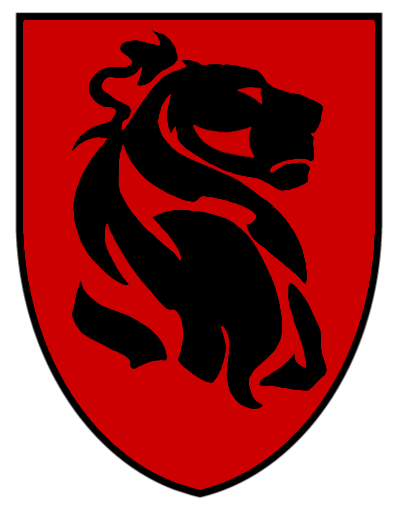Quest Log and Historical Notes
for Echoes of Ragnarok
for Echoes of Ragnarok
❧ The Gilded Lion Summer Festival, June 27, 1015:
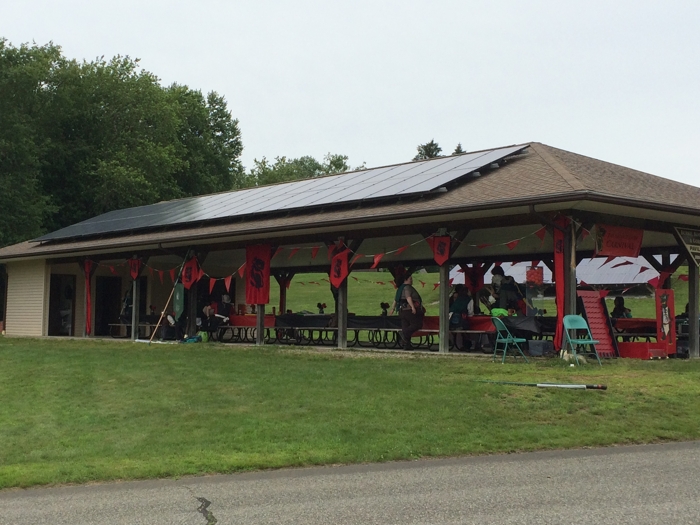 It was a calm but cloudy summer day when the heroes of the Realms arrived in Southland, Rhiassa, just after the solstice. They had come at the bequest of Lady Dame Areni, who had invited everyone to a gathering she was calling the Gilded Lion Summer Festival. Areni had planned a day of good food, fun tournaments, and relaxing in the summer sun, though she would soon find that fate had other plans for the day.
It was a calm but cloudy summer day when the heroes of the Realms arrived in Southland, Rhiassa, just after the solstice. They had come at the bequest of Lady Dame Areni, who had invited everyone to a gathering she was calling the Gilded Lion Summer Festival. Areni had planned a day of good food, fun tournaments, and relaxing in the summer sun, though she would soon find that fate had other plans for the day.
In the days and weeks before the festival, it was hard to ignore the unseasonably frequent and intense thunderstorms. Reports of lightning strikes in the nearby woodlands had increased to alarming rates, and by the time the day of the festival arrived, Lord Sir Aeston had little choice but to take out an adventuring party of his knights and squires and investigate the matter before all of their guests arrived. Whatever they found, however, had delayed their return and as their guests arrived, Areni greeted them alone.
She welcomed everyone to a day of festivities and fun but such plans were short lived. For mere minutes after she had gathered everyone together a clap of thunder was heard in the woods nearby and from within them emerged a band of men and women, dressed in furs and leather and armed with axes and swords. The man at the head of their formation yelled out "Jomsvikings, forward!", and the strange warriors marched towards the pavilion where the heroes of the Realms were gathered. Rather than charge forward with weapons drawn, however, these foreign people raised their hands in truce, and asked if they had finally stumbled upon a place known as The Realms.
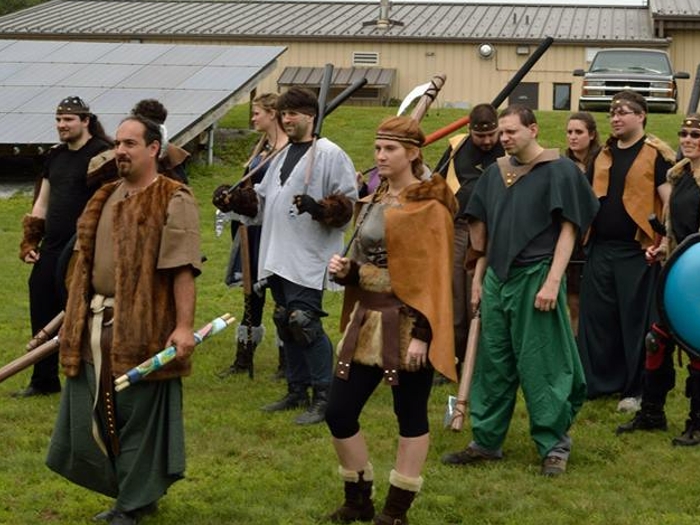 These were the Jomsvikings, lead by a man named Ulric. They had journeyed far across the many dimensions with the help of their gods to find The Realms. Ulric told the assembled heroes their story, of their world, Norlund, on the verge of Ragnarok, of the invasion of a unfathomable enemy that they called The Black Death, of the slow but inevitable defeat of the armies of god and man, and then of the enemy's sudden and inexplicable disappearance, leaving their world barren, still, and unable to join the holy battle of Ragnarok that would have allowed their world to be reborn. They had learned that the ultimate defeat of The Black Death was at the hands of the heroes of The Realms, and had come to ask their aid in repairing their broken world and allowing Ragnarok to commence.
These were the Jomsvikings, lead by a man named Ulric. They had journeyed far across the many dimensions with the help of their gods to find The Realms. Ulric told the assembled heroes their story, of their world, Norlund, on the verge of Ragnarok, of the invasion of a unfathomable enemy that they called The Black Death, of the slow but inevitable defeat of the armies of god and man, and then of the enemy's sudden and inexplicable disappearance, leaving their world barren, still, and unable to join the holy battle of Ragnarok that would have allowed their world to be reborn. They had learned that the ultimate defeat of The Black Death was at the hands of the heroes of The Realms, and had come to ask their aid in repairing their broken world and allowing Ragnarok to commence.
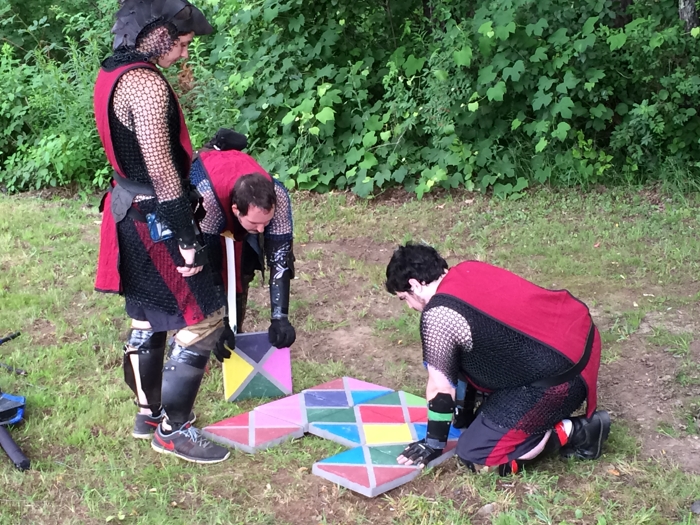 The Norlund gods had combined their power to allow the Jomsvikings to travel to the Realms, but in order for them to return, and for the connection between the worlds to be traversable in the future, a gate would have to be built to anchor what would be called the Vanfrost, the path of shadow. For this gate to be constructed, the heroes of the Realms would have to complete challenges from the Norlund gods to increase their influence and potency within Rhiassa. They split themselves up into small groups, and spread out around the lands to find the quests to complete.
The Norlund gods had combined their power to allow the Jomsvikings to travel to the Realms, but in order for them to return, and for the connection between the worlds to be traversable in the future, a gate would have to be built to anchor what would be called the Vanfrost, the path of shadow. For this gate to be constructed, the heroes of the Realms would have to complete challenges from the Norlund gods to increase their influence and potency within Rhiassa. They split themselves up into small groups, and spread out around the lands to find the quests to complete.
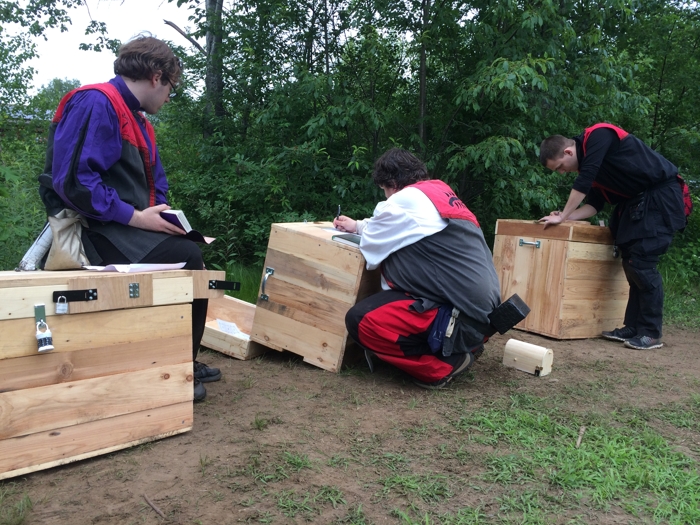 From Loki, master of trickery and secrets, they were challenged to navigate their way through a series of puzzles and locks to open a set of mysterious boxes. From Bragi, the god of poetry and music, they were tasked to put a Norlund legend to song using an instrument called a dulcimer. From Baldur, the patron of art and beauty, they were required to paint a picture of a scene from the Norlund countryside. From Hoenir, the lord of creation of silence they had to work together without speaking to build a model of a longboat. From Hlin, the mistress of protection, they had to defend a series of points in the woodlands from an invading kobold army. From Magni, the god of strength, they were asked to complete a set of challenges the required the use of both their muscles and their brains. From Freyr the goddess of fertility and growth they sought to deliver blessed water to flowers that would otherwise die. From Ullr, the master of the hunt, they needed to earn arrows and then use them to shoot game to give as sacrifice. Finally the heroes competed in various tournaments and tests of martial skill to appease Tyr, the god of battle.
From Loki, master of trickery and secrets, they were challenged to navigate their way through a series of puzzles and locks to open a set of mysterious boxes. From Bragi, the god of poetry and music, they were tasked to put a Norlund legend to song using an instrument called a dulcimer. From Baldur, the patron of art and beauty, they were required to paint a picture of a scene from the Norlund countryside. From Hoenir, the lord of creation of silence they had to work together without speaking to build a model of a longboat. From Hlin, the mistress of protection, they had to defend a series of points in the woodlands from an invading kobold army. From Magni, the god of strength, they were asked to complete a set of challenges the required the use of both their muscles and their brains. From Freyr the goddess of fertility and growth they sought to deliver blessed water to flowers that would otherwise die. From Ullr, the master of the hunt, they needed to earn arrows and then use them to shoot game to give as sacrifice. Finally the heroes competed in various tournaments and tests of martial skill to appease Tyr, the god of battle.
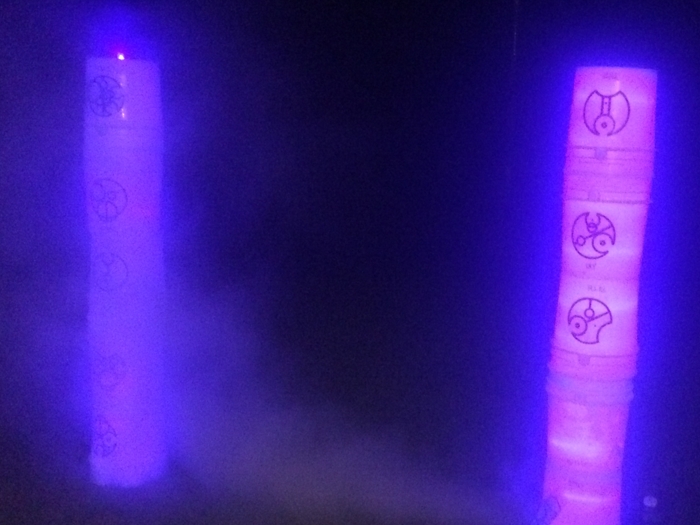 As the heroes successfully completed test after test, the gods gifted them with cylindrical stones of white marble, and written upon each of them were strange circular runes. Winning Tyr's favor in battle helped to unlock the secrets of this strange writing, which was called Asgardian Starscript. The adventurers learned that each stone represented a word, and to build the gate that would connect Norlund to Rhiassa, they needed to construct a set of columns that created a rhyming couplet that bore the meaning of where they wanted to travel.
As the heroes successfully completed test after test, the gods gifted them with cylindrical stones of white marble, and written upon each of them were strange circular runes. Winning Tyr's favor in battle helped to unlock the secrets of this strange writing, which was called Asgardian Starscript. The adventurers learned that each stone represented a word, and to build the gate that would connect Norlund to Rhiassa, they needed to construct a set of columns that created a rhyming couplet that bore the meaning of where they wanted to travel.
As Areni served dinner, the heroes of the Realms translated these runes and built the gate. When the last of the sun had disappeared beyond the horizon and the darkness has settled on Southland, the gate was finally completed, glowing from within with a strange, blue energy. The Jomsvikings, now able to return to their home, thanked the heroes of the Realms for their service, and secured from them the promise that they would, themselves, travel through the Vanfrost that coming fall for their first of many missions to put right the lands of Norlund.
❧ Echoes of Ragnarok: Svartalvheim, November 21, 1015:
Having traveled back over the Vanfrost, securing the promise of aid from the heroes of the Realms, Ulric and his Jomsvikings followed through on their intentions and managed to commune with the remaining gods to learn how that heroic effort might best be spent. So on one fall day, passing again through the Vanfrost to Rhiassa, he summoned forth the adventurers who had pledged their aid and bode them to travel to Svartelvheim, a world made of nothing but earth and caverns, the domain of the dwarves and the black elves. There they were to try and convince the dwarven race, master blacksmiths all, to reforge the Heilvápin, the gods weapons, that were consumed in the fight with the Black Death.
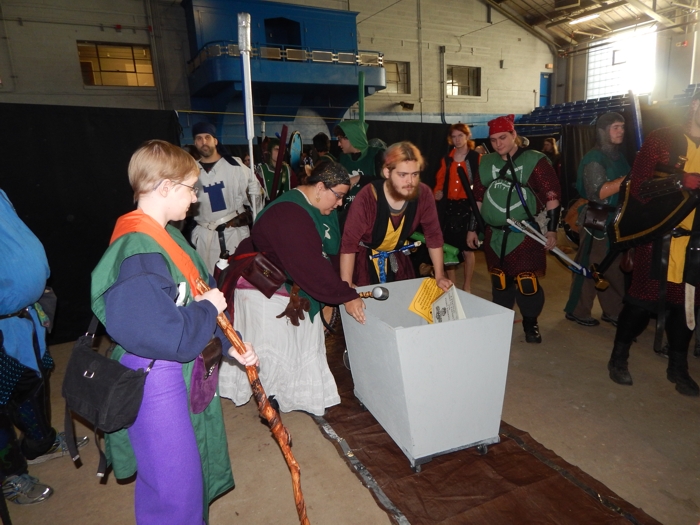 So the heroes did assemble, and rearranging the gate of the Vanfrost to direct their travel to Svartlevhiem, traveled across the shadowed path to the worlds of Norlund. They arrived in a cavern bereft of living creatures, but one that certainly must have been bustling with activity once, for the remnants of a mining operation were there for all to see. A minecart on its tracks, pickaxes, hammers, even a guide to the dwarven methods of forging weapons. The adventurers quickly figured out that there was magically empowered ore in the walls of the caverns, and that it could be mined and freed. Good news, since it's magical power seemed to restore to them the use of spells that they were bereft of after passing through the gate.
So the heroes did assemble, and rearranging the gate of the Vanfrost to direct their travel to Svartlevhiem, traveled across the shadowed path to the worlds of Norlund. They arrived in a cavern bereft of living creatures, but one that certainly must have been bustling with activity once, for the remnants of a mining operation were there for all to see. A minecart on its tracks, pickaxes, hammers, even a guide to the dwarven methods of forging weapons. The adventurers quickly figured out that there was magically empowered ore in the walls of the caverns, and that it could be mined and freed. Good news, since it's magical power seemed to restore to them the use of spells that they were bereft of after passing through the gate.
Making their way through the cave, pushing the minecart along its track, they soon found the denizens of this underground world. They were attacked by dwarves... but not the noble creatures that they were directed to speak to, rather, their reanimated flesh being controlled by black elves that stood behind them. The heroes had no choice but to fight their way through, none of these creatures seemed interested in parlay. And so their quest began, fighting their way through caverns, resolving odd magical circuits requiring gemstones to open doors or switch tracks, demolishing walls in their way with barrels of TNT, mining piles upon piles of ore and pushing it forward along with them in their cart.
 Before long, the adventurers came upon a magical dwarven forge. Set upon it was a pattern for a weapon that they had to decode. This involved placing the colored, magical ore on a grid. Once they were sure they had solved the puzzle they struck the forge with the smith's hammer that they had found and the ore melded together to form a sword. What is more, that sword, clearly one of the Heilvápin, had many great powers. Most notably, the ability to smite elves that it struck. Along they way the adventures would find more of these forges, each with its own pattern, and one after they created the weapons of the gods, hammers, axes, a shield, a bow, even a flail.
Before long, the adventurers came upon a magical dwarven forge. Set upon it was a pattern for a weapon that they had to decode. This involved placing the colored, magical ore on a grid. Once they were sure they had solved the puzzle they struck the forge with the smith's hammer that they had found and the ore melded together to form a sword. What is more, that sword, clearly one of the Heilvápin, had many great powers. Most notably, the ability to smite elves that it struck. Along they way the adventures would find more of these forges, each with its own pattern, and one after they created the weapons of the gods, hammers, axes, a shield, a bow, even a flail.
Traveling cave after cave, the heroes came upon a scene unlike those before. A cavern filled with magma, fire elementals and imps spewing about balls of flame. Perhaps to many that would not seem an odd sight, but those who understood the worlds of Yggdrasil knew that these were creatures of Muspelheim, and there was no sense to why they would be within a realm of earth. Later on, the heroes encountered a cavern where two eldjötnar, fire giants, wandered around the chamber aimlessly. It was clear that something was greatly amiss in Svartlevhiem.
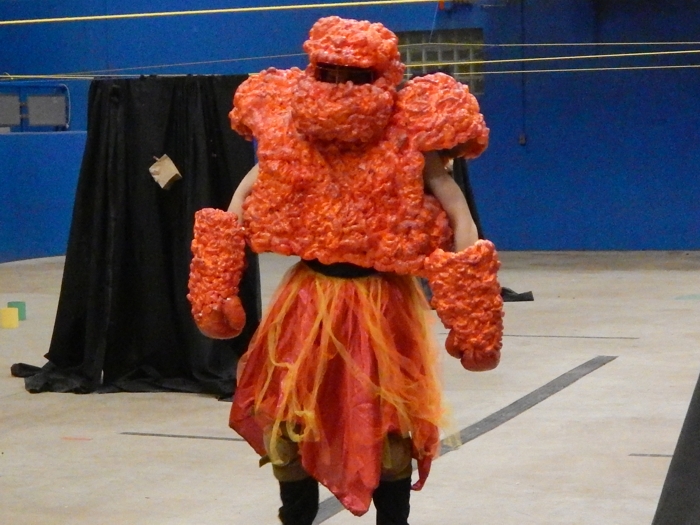 Continuing their journey the heroes found signs that what remained of dwarven civilization must be close, as they stumbled upon some deactivated mining automatons. Soon afterwards, while resting in a narrow corridor, they heard a booming voice ring out, challenging their presence so close to the last remaining bastion of dwarven power in a world that was quickly succumbing to the black elf menace. This was Wéland, and though he was not king of the dwarves, he served in that role now, as the lords and kings above him had all been killed in the fight against the Black Death. Wéland was, however, the most renowned of the dwarven smiths, and the design of many of the Heilvápin was his doing.
Continuing their journey the heroes found signs that what remained of dwarven civilization must be close, as they stumbled upon some deactivated mining automatons. Soon afterwards, while resting in a narrow corridor, they heard a booming voice ring out, challenging their presence so close to the last remaining bastion of dwarven power in a world that was quickly succumbing to the black elf menace. This was Wéland, and though he was not king of the dwarves, he served in that role now, as the lords and kings above him had all been killed in the fight against the Black Death. Wéland was, however, the most renowned of the dwarven smiths, and the design of many of the Heilvápin was his doing.
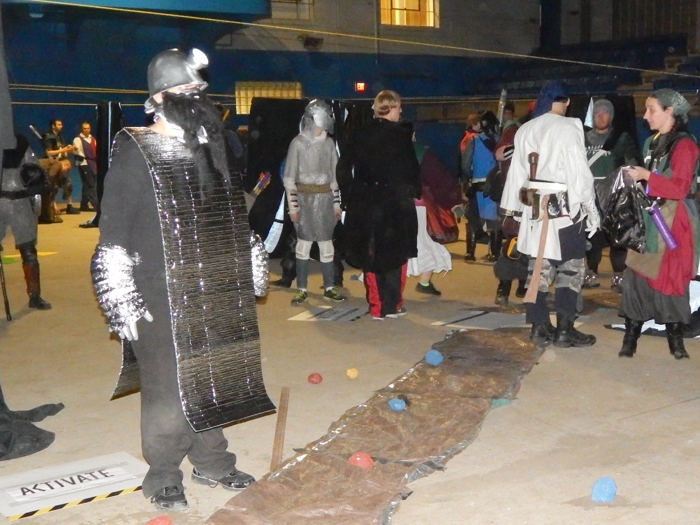 Wéland had found the heroes while returning from his own very dangerous mission. The black elves, always the enemies of the dwarves but still intent of joining all the races in Ragnarok, had somehow come to the decision that they would rather rule this world than cede to its rebirth in the cycle. And so they resolved to wipe out the dwarves and eliminate the chance that the gods could ever receive new weapons by their hands. Wéland's castle and the remnants of his people were besieged by the champions of the black elves, and above them, a champion of champions that the dwarven warriors had no chance of defeating for it required the power of the gods to do so.
Wéland had found the heroes while returning from his own very dangerous mission. The black elves, always the enemies of the dwarves but still intent of joining all the races in Ragnarok, had somehow come to the decision that they would rather rule this world than cede to its rebirth in the cycle. And so they resolved to wipe out the dwarves and eliminate the chance that the gods could ever receive new weapons by their hands. Wéland's castle and the remnants of his people were besieged by the champions of the black elves, and above them, a champion of champions that the dwarven warriors had no chance of defeating for it required the power of the gods to do so.
Wéland, therefore, had risked life and limb to find an ancient vault and within it the pattern to forge Mjölnir, the holy weapon of Thor himself. Receiving the pledge of the adventurers' aid, he bade them to enter his fortress, for the Heilvápin that they wielded could defeat the black elf champions who wielded corrupted Heilvápin of their own making, and once they were slain, and assault could be made on the champion of champions, himself.
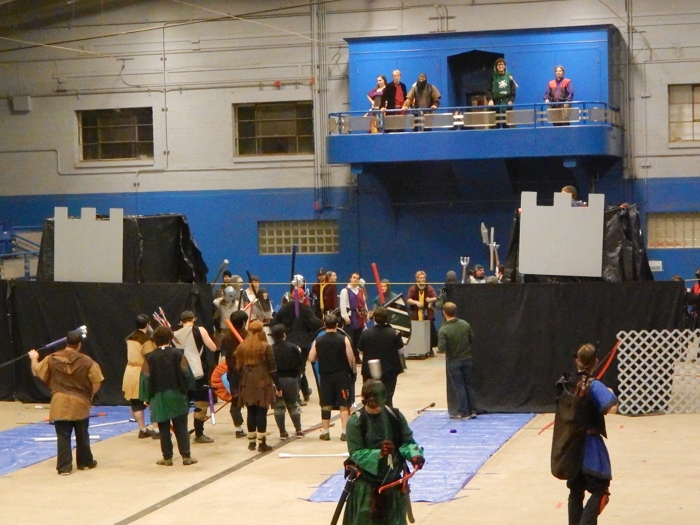 The heroes emerged from the cavern into three tiers of a giant keep. Just as they collected in the courtyard, a wave of black elves rushed forward and broke what remained of the battered front gate. The adventurers met their attack, however, and held them at the entrance to the keep. One by one the dark elf champions were challenged, and as the heroes defeated them with matching Heilvápin, both of the weapons vanished as their energies negated one another. Meanwhile, one more time, the magical forge of the dwarves was activated and from the pattern and ore was produced Mjölnir.
The heroes emerged from the cavern into three tiers of a giant keep. Just as they collected in the courtyard, a wave of black elves rushed forward and broke what remained of the battered front gate. The adventurers met their attack, however, and held them at the entrance to the keep. One by one the dark elf champions were challenged, and as the heroes defeated them with matching Heilvápin, both of the weapons vanished as their energies negated one another. Meanwhile, one more time, the magical forge of the dwarves was activated and from the pattern and ore was produced Mjölnir.
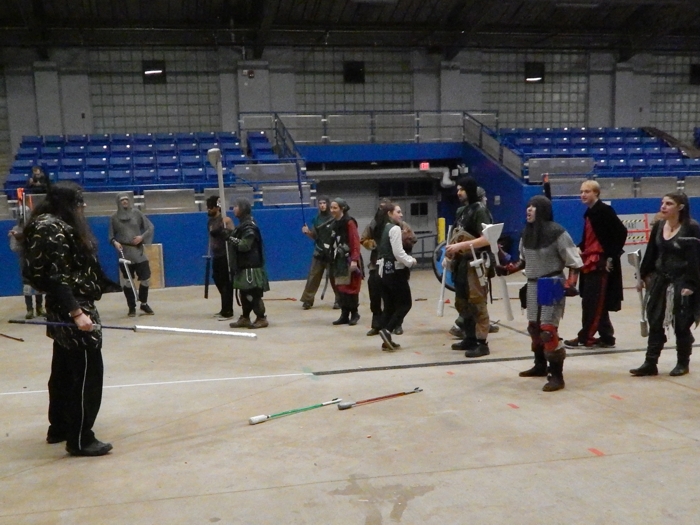 Finally, with each of the champions vanquished, the heroes pushed forward to the outside of the keep, past the army of black elves, to the champion of champions that stood waiting for a worthy foe. As he roared out his challenge and strode forth, ready to strike, one brave hero summoned forth the power of Mjölnir and fired into his breast a lightning bolt of godly potency. Clutching his chest the champion fell forward, defeated.
Finally, with each of the champions vanquished, the heroes pushed forward to the outside of the keep, past the army of black elves, to the champion of champions that stood waiting for a worthy foe. As he roared out his challenge and strode forth, ready to strike, one brave hero summoned forth the power of Mjölnir and fired into his breast a lightning bolt of godly potency. Clutching his chest the champion fell forward, defeated.
Wéland was overjoyed. With the greatest of the black elf warriors defeated, what remained of his people could finally gain ground and begin mining once again. He pledged himself and the rest of the smiths of his people to reforging the Heilvápin and rearming the remaining gods for the battle at the end of the world. Victorious, the heroes were able to travel home on the Vanfrost until the next time Norlund required their aid.
❧ The Gilded Lion Summer Festival II, Echoes of Ragnarok: Himmelberget, June 25, 1016
The missive came in early spring from Ulric, leader of the Jomsvikings. Once again he had, though investigation and consultation with the soothsayers, found a way that the heroes of the Realms could continue to aid the worlds of Norlund, setting right what was made wrong by the Black Death. So on a brutally warm summer day, the Adventurers gathered on the fields of Rhiassa, where the Vanfrost was first constructed, and met Urlic so he could explain to them, in detail, their next mission. Alongside Ulric this time was an armored woman, she appeared beautiful and mighty and cradled in her arms a giant horn, and behind her stretched a pair of large, angelic wings. This was Aela, a Valkyrie serving the god Heimdall. Urlic asked her to describe to the assembled heroes what was amiss with her master's domain and how it might be repaired.
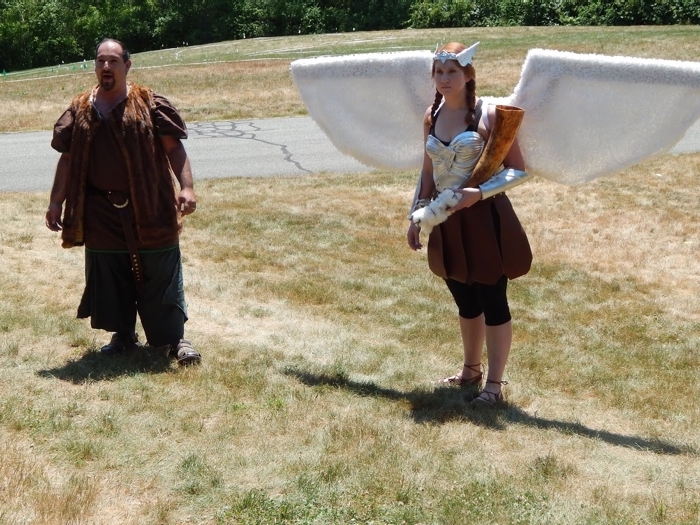 Aela explained that Heimdall was the warden of the countless and complex paths that stretched through Yggdrasil and that, at the height of his power, no being could pass through the World Tree without his ascent. In the war against the Black Death, however, these many pathways were all destroyed and Heimdall's power had waned to the extent that he could not re-establish them. What is more, somehow, beyond their understanding, creatures from several of Norlund's worlds had started to find their way through the tree, taking paths unknown to Heimdall and that were beyond his ability to safeguard, so had his power been scattered beyond his reach.
Aela explained that Heimdall was the warden of the countless and complex paths that stretched through Yggdrasil and that, at the height of his power, no being could pass through the World Tree without his ascent. In the war against the Black Death, however, these many pathways were all destroyed and Heimdall's power had waned to the extent that he could not re-establish them. What is more, somehow, beyond their understanding, creatures from several of Norlund's worlds had started to find their way through the tree, taking paths unknown to Heimdall and that were beyond his ability to safeguard, so had his power been scattered beyond his reach.
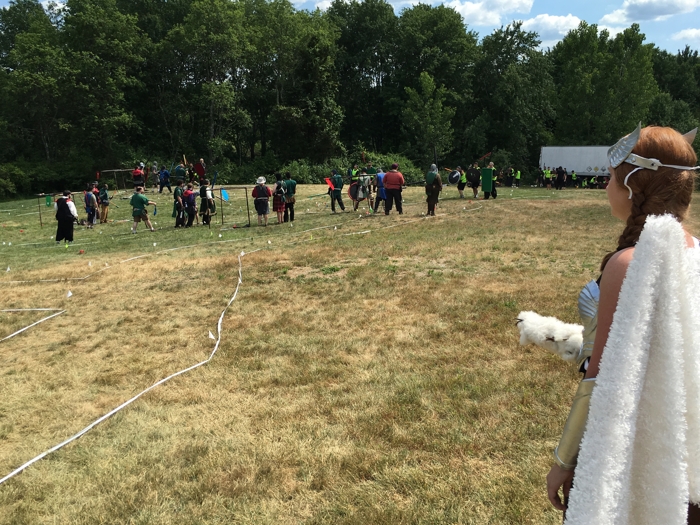 The duty of the heroes, therefore, was to set up defenses along these unknown pathways in the form of "nodes". These nodes would allow the heroes to lay claim to certain powers within Yggdrasil, which would normally suppress most of their strength or mystical power. Viking nodes would allow heroes to be armored and to fight with increasingly larger weapons. Hunter nodes would give the heroes the ability to rain arrows on their opponents. Mystic nodes granted the heroes the ability to cast most of their spells and especially to blast their foes with magic missiles. Finally, siege nodes empowered the heroes to be able to throw boulders at the advancing armies. It was up to the heroes how they would arrange these nodes, for each had an area of influence that was quite small, and their goal was guard all of the ways through the many crisscrossing paths of Yggdrasil.
The duty of the heroes, therefore, was to set up defenses along these unknown pathways in the form of "nodes". These nodes would allow the heroes to lay claim to certain powers within Yggdrasil, which would normally suppress most of their strength or mystical power. Viking nodes would allow heroes to be armored and to fight with increasingly larger weapons. Hunter nodes would give the heroes the ability to rain arrows on their opponents. Mystic nodes granted the heroes the ability to cast most of their spells and especially to blast their foes with magic missiles. Finally, siege nodes empowered the heroes to be able to throw boulders at the advancing armies. It was up to the heroes how they would arrange these nodes, for each had an area of influence that was quite small, and their goal was guard all of the ways through the many crisscrossing paths of Yggdrasil.
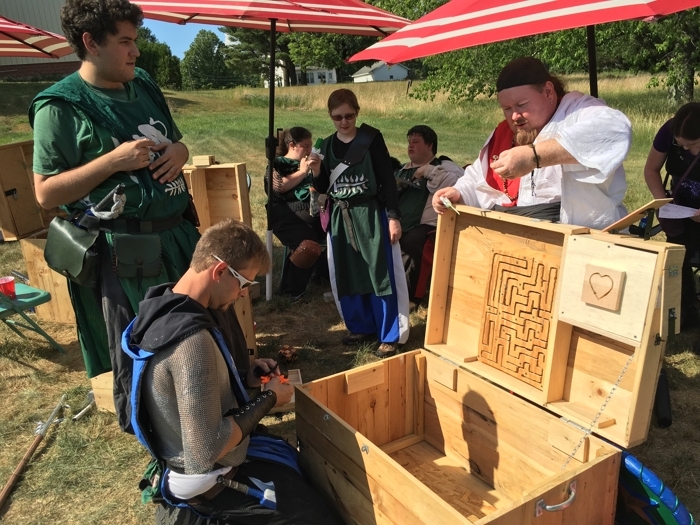 The waves of enemies came one after the other, black elves, dwarves, vikings, kobolds, trolls, fire imps and jotun. Troops from many different places all marching the same way through the paths. At first it was difficult to hold back their continuous assault, but as the players stuck down these monsters, small purple crystals were emitted. Collecting the crystals helped to restore some of Heimdall's power to him, and therefore gave the heroes the ability to build new nodes and make the existing ones stronger. Along the paths, heroes also found strange numerical maps which allowed them to rediscover ley lines as they were decoded. These resulted in restoring power to Heimdall as well. While these battles raged, Loki gave to the quest his own mysterious aid, placing several locked chests full of tricks and puzzles for the heroes to navigate through to earn his help.
The waves of enemies came one after the other, black elves, dwarves, vikings, kobolds, trolls, fire imps and jotun. Troops from many different places all marching the same way through the paths. At first it was difficult to hold back their continuous assault, but as the players stuck down these monsters, small purple crystals were emitted. Collecting the crystals helped to restore some of Heimdall's power to him, and therefore gave the heroes the ability to build new nodes and make the existing ones stronger. Along the paths, heroes also found strange numerical maps which allowed them to rediscover ley lines as they were decoded. These resulted in restoring power to Heimdall as well. While these battles raged, Loki gave to the quest his own mysterious aid, placing several locked chests full of tricks and puzzles for the heroes to navigate through to earn his help.
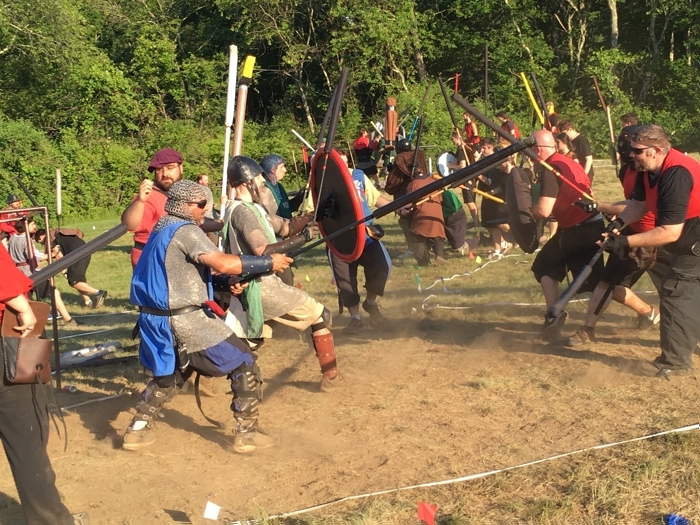 As the battle continued throughout the day, a hulking figure of a man appeared at the paths. This was Olaf Skullspiltter, the proclaimed general of these forces. He warned the heroes that they stood against a great and noble effort that his armies were a part of, and bade them to abandon their attempts to belay him. The heroes stood resolute and the waves upon waves of enemies continues to try and force their way through the paths.
As the battle continued throughout the day, a hulking figure of a man appeared at the paths. This was Olaf Skullspiltter, the proclaimed general of these forces. He warned the heroes that they stood against a great and noble effort that his armies were a part of, and bade them to abandon their attempts to belay him. The heroes stood resolute and the waves upon waves of enemies continues to try and force their way through the paths.
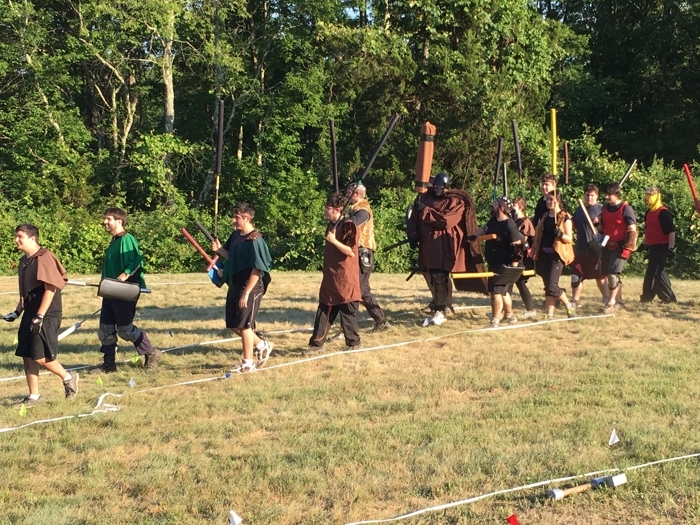 As the sun lowered in the sky, the Loki boxes were finally unlocked. Within them, the trickster god's aid allowed the heroes to shut down one of the pathways through Yggdrasil. Meanwhile, Olaf Skullsplitter took the field once again, flanked on either side by the largest and most powerful array of troops that he had yet to display. Fortunately, the heroes had worked and strategies throughout the day to create an array of nodes that could withstand the assault. As the thunderously powerful viking surged forward greatswords swung, arrows were loosed, missiles rained down, and boulders crushed enemies in their path. When the dust cleared, Olaf fell, clutching his chest, crying out "My jarl, I have failed you!", before collapsing onto the dirt.
As the sun lowered in the sky, the Loki boxes were finally unlocked. Within them, the trickster god's aid allowed the heroes to shut down one of the pathways through Yggdrasil. Meanwhile, Olaf Skullsplitter took the field once again, flanked on either side by the largest and most powerful array of troops that he had yet to display. Fortunately, the heroes had worked and strategies throughout the day to create an array of nodes that could withstand the assault. As the thunderously powerful viking surged forward greatswords swung, arrows were loosed, missiles rained down, and boulders crushed enemies in their path. When the dust cleared, Olaf fell, clutching his chest, crying out "My jarl, I have failed you!", before collapsing onto the dirt.
With the defeat of Olaf, and the considerable amount of power that the adventurers were able to restore to Heimdall, the warden god could, himself, safeguard these strange new paths through the World Tree. Where these paths first came from, however, as well as the origin of the enemies that besieged them and the mysterious jarl behind it all... these mysteries must linger until another day.
❧ Echoes of Ragnarok II: Muspelheim, December 3, 1016
As was the habit by now, a missive from Ulric of the Jomsvikings reached the heroes of the Realms, once again beseeching them for their aid in fixing the broken worlds of Norlund and rekindling the holy war of Ragnarok. Following the trail of the Fire Jotun that they fought at Himmelberget, Urlic had turned the sights of his mystics upon Muspelheim, their lands of origin, with the thought that it might be the source of whatever enemies are standing in the way of the heroes' aims. When Urlic met the adventurers to inform them of his findings and begin their excursion into the domain of fire, he had with him a grizzled old dwarf named Baern who was familiar with Muspelheim, an emissary sent by the recently crowned King Wéland to help guide the heroes on their journey.
Ulric had learned that the ruler of Muspelheim, Surtr, had been killed but not by the Black Death that ravaged so many of the peoples of Norlund. His death had occurred much more recently. Thankfully, Fire Jotun cannot be killed eternally so long as they are in their own domain, and given that Surtr's flames were destined to be those that burned the world in Ragnarok, returning him to life was not only possible, it was urgent. To give new life to the Flame Lord, his ashes would need to be collected and thrown into the eldritch pyre so that he could be reborn from its energy. Baern had managed, through his contacts, to acquire an urn that held some of those very ashes, but he also knew there were five more that the adventurers would have to locate. So across the Vanfrost they traveled to the world of flame.
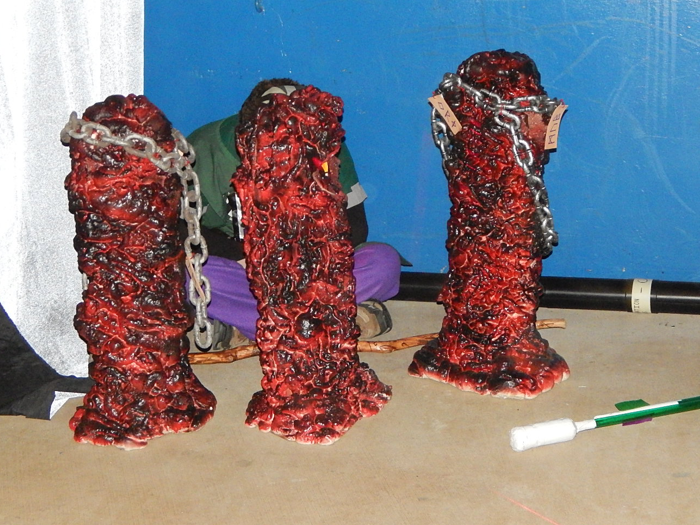 Muspelheim is not a place where mortals can survive for long, but using magical totems the heroes were able to create a zone of safety within the fiery domain. For the most part they all had to stay together as they moved these totems along with them, but they also found they could craft magical jewelry from charms to make them immune to the environment. As time went on through the day they found different sorts of charms as well as recipes to make other varieties of jewelry to empower them. As they progressed through the canyons of onyx and fire, the adventurers found themselves at battle with red, horned creatures, devils of Norlun who were called the faenfolk. These demons opposed them at every turn alongside the occasional fire jotun as well. Slowly but surely, however, the heroes made their way forward.
Muspelheim is not a place where mortals can survive for long, but using magical totems the heroes were able to create a zone of safety within the fiery domain. For the most part they all had to stay together as they moved these totems along with them, but they also found they could craft magical jewelry from charms to make them immune to the environment. As time went on through the day they found different sorts of charms as well as recipes to make other varieties of jewelry to empower them. As they progressed through the canyons of onyx and fire, the adventurers found themselves at battle with red, horned creatures, devils of Norlun who were called the faenfolk. These demons opposed them at every turn alongside the occasional fire jotun as well. Slowly but surely, however, the heroes made their way forward.
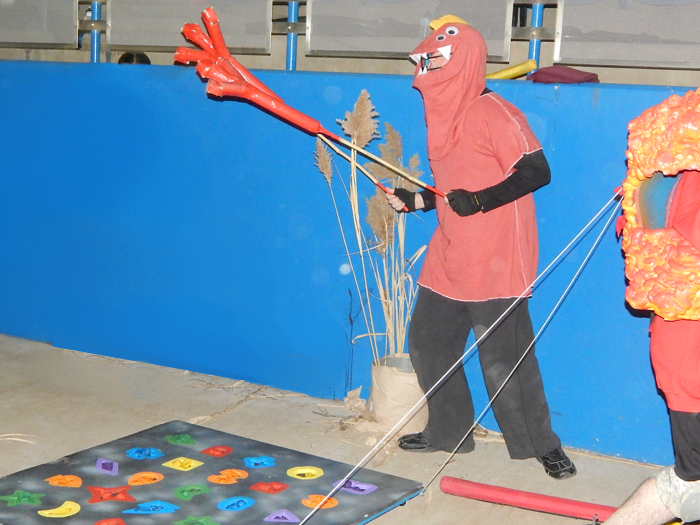 Soon they came to a large cavern that had in the center one of the urns that they sought. It was, however, irretrievable under a dome of unbreakable class. Around the room a jotun marched, tethered to a board covered with many shaped holes. Meanwhile, strange lizards lurked in the corridors, protecting their nests and their clutches of eggs. These salamanders were mighty foes and their skin was so tough that weapons broke across their hides. The heroes, however, were well prepared and were able to defeat many of these monsters with magic or arrows. As they cracked open the eggs in each nest they found a colored goo that was needed to fill in the board pulled by the Jotun. It was only after they were each covered that a mechanism was triggered and the urn was recovered from the pedestal in the center of the room.
Soon they came to a large cavern that had in the center one of the urns that they sought. It was, however, irretrievable under a dome of unbreakable class. Around the room a jotun marched, tethered to a board covered with many shaped holes. Meanwhile, strange lizards lurked in the corridors, protecting their nests and their clutches of eggs. These salamanders were mighty foes and their skin was so tough that weapons broke across their hides. The heroes, however, were well prepared and were able to defeat many of these monsters with magic or arrows. As they cracked open the eggs in each nest they found a colored goo that was needed to fill in the board pulled by the Jotun. It was only after they were each covered that a mechanism was triggered and the urn was recovered from the pedestal in the center of the room.
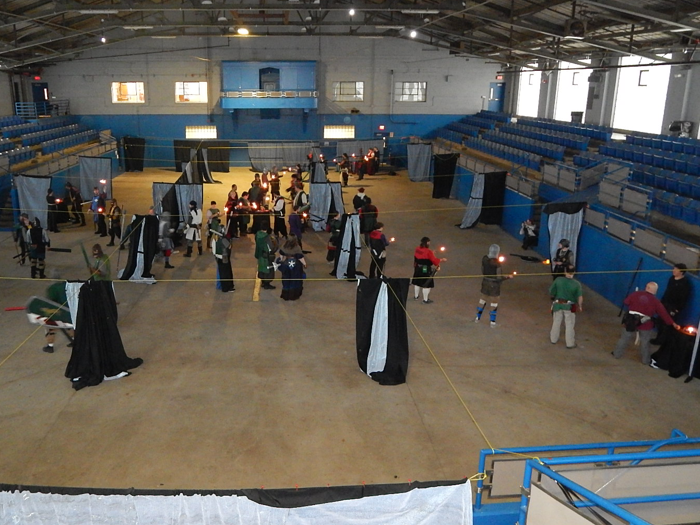 Afterwards the heroes entered another cavern, again with an urn in the center under a glass dome. This time there were flames lit around the sides of the room and three unlit candles surrounding the urn on the center pedestal. With the burning flames sat a pile of strange sticks that would spark with bright light when they were lit, but only for a short time. What is more, the sparking flame was so unnaturally heavy that a person holding a lit stick could not move their feet. The heroes, through trial and error, learned that they had to create a cascade of flame from the candles around the sides of the room to the candles in the center. Forming long chains of people they passed the flame from one to the other by lighting the sparking sticks off of one another across the vast cavern, igniting the flames in the center all at once. As they each flickered to life, the dome in the center clicked open and the adventurers recovered the urn.
Afterwards the heroes entered another cavern, again with an urn in the center under a glass dome. This time there were flames lit around the sides of the room and three unlit candles surrounding the urn on the center pedestal. With the burning flames sat a pile of strange sticks that would spark with bright light when they were lit, but only for a short time. What is more, the sparking flame was so unnaturally heavy that a person holding a lit stick could not move their feet. The heroes, through trial and error, learned that they had to create a cascade of flame from the candles around the sides of the room to the candles in the center. Forming long chains of people they passed the flame from one to the other by lighting the sparking sticks off of one another across the vast cavern, igniting the flames in the center all at once. As they each flickered to life, the dome in the center clicked open and the adventurers recovered the urn.
After winding their way through several other passages, fighting faenfolk, jotun, and salamanders along the way, the heroes found themselves in a sparse forest, with logs and boards in piles on the ground along with a stack of unarmed traps. Baern noted that they had found themselves in the Dark Forest, a place where trees unaffected by Muspelheim's fires were able to grow. Baern warned the questing party that lately the wooded land had become the territory of a seemingly endless horde of undead - a strange type of creature to be be found in the world of flame. In the center, near the piles of wood, was another urn on a pedestal, this one accompanied by a scale with a great weight on one side. Baern advised that the heroes had the best chance of survival in these hostile lands if they used the building materials they could scavenge to build a fortification and arm some traps.
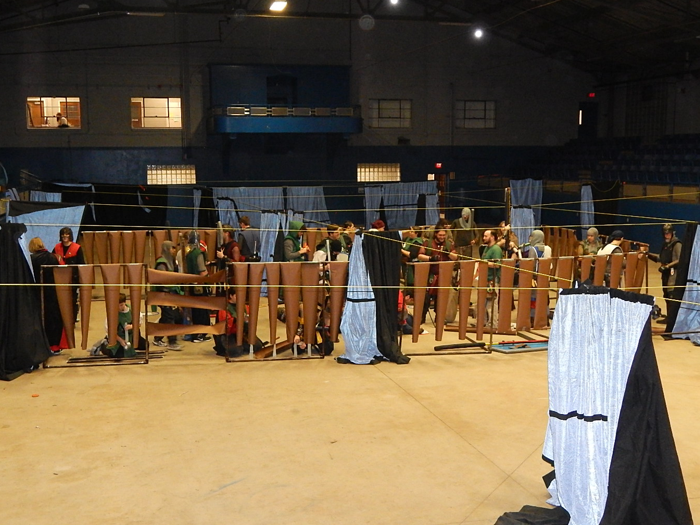 Just as the final boards were being placed in the walls of their fortress, the undead came pouring out of the surrounding landscape. They threw themselves at the walls of the fortification, using boulders to try and tear open avenues of attack, but the heroes rebuffed them each time and quickly rebuilt everything that was broken. Even when a fire jotun joined the fray the massive damage that he inflicted on the walls was easily set to right. Heroes were manning the traps, they were repairing structural damage, and they were slaughtering each undead that approached, pulling off each of them a bone chip that they placed on the scale near the urn. It took many warriors killing many skeletons to do it, but eventually the scale was balanced between the bone chips and the weight, and the dome covering the urn clicked open. The undead retreated in failure.
Just as the final boards were being placed in the walls of their fortress, the undead came pouring out of the surrounding landscape. They threw themselves at the walls of the fortification, using boulders to try and tear open avenues of attack, but the heroes rebuffed them each time and quickly rebuilt everything that was broken. Even when a fire jotun joined the fray the massive damage that he inflicted on the walls was easily set to right. Heroes were manning the traps, they were repairing structural damage, and they were slaughtering each undead that approached, pulling off each of them a bone chip that they placed on the scale near the urn. It took many warriors killing many skeletons to do it, but eventually the scale was balanced between the bone chips and the weight, and the dome covering the urn clicked open. The undead retreated in failure.
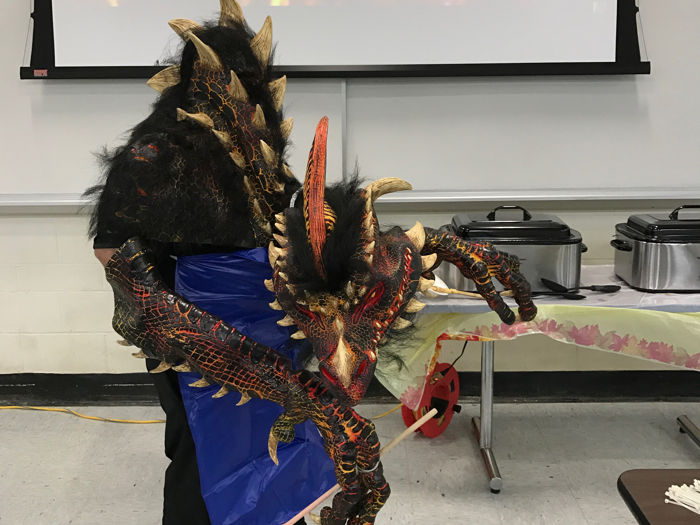 The day had grown long, at this point, and Baern, who was not an adventurer by nature, was unable to go much longer without provisions. Serendipitously enough, as the questing party left the Dark Forest, Baern's sharp nose caught the scent of food cooking on the nearby mountain. Following the dwarf, the heroes of the Realms climbed the steep mountainside and found themselves staring into the lair of a dragonesque creature who was clearly engaged in cooking a large meal. Unexpectedly hospitable, the dragon, who called himself Ember, welcomed the heroes to him home and bade them to eat. As they filled themselves with the provided meal, Ember explained that Surtr, the lord of Muspelheim, was killed by his own brother and his retainers to try and usurp the rule of the realm for their own. They had formed an army with the help of the mysterious faenfolk and all together they sought to prevent the battle of Ragnarok from occurring. They would much rather say alive and stay in command of the land of flame.
The day had grown long, at this point, and Baern, who was not an adventurer by nature, was unable to go much longer without provisions. Serendipitously enough, as the questing party left the Dark Forest, Baern's sharp nose caught the scent of food cooking on the nearby mountain. Following the dwarf, the heroes of the Realms climbed the steep mountainside and found themselves staring into the lair of a dragonesque creature who was clearly engaged in cooking a large meal. Unexpectedly hospitable, the dragon, who called himself Ember, welcomed the heroes to him home and bade them to eat. As they filled themselves with the provided meal, Ember explained that Surtr, the lord of Muspelheim, was killed by his own brother and his retainers to try and usurp the rule of the realm for their own. They had formed an army with the help of the mysterious faenfolk and all together they sought to prevent the battle of Ragnarok from occurring. They would much rather say alive and stay in command of the land of flame.
Ember, however, gave the heroes a great boon. Not only was one of the urns in his possession, which he readily handed over to the adventurers, he also explained to them that in order for Surtr to be returned to life, not only his ashes, but also the pieces of the obsidian crown now worn by his brother must be all together joined in the eldritch fire that would rebirth the lord of flame. There was only one more urn that must be found before the heroes could achieve this goal.
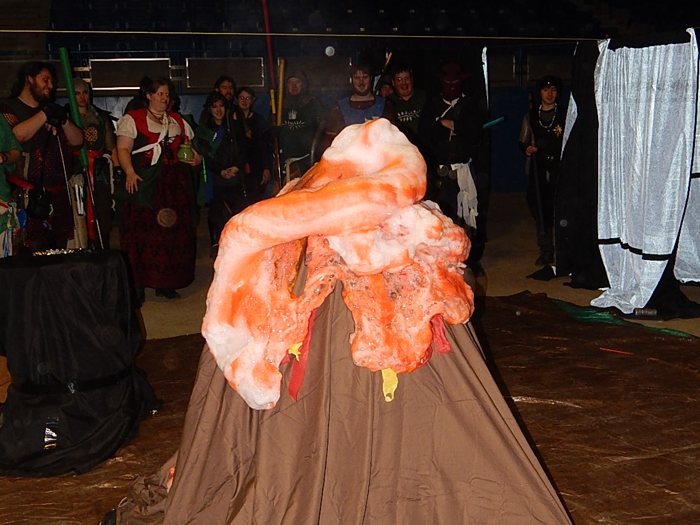 Leaving Ember's lair the heroes found themselves atop a volcano that appeared to have been dormant for some time. Next to the mouth sat a strange goblet atop a pedestal and efforts to figure out why it was there revealed that it was a receptacle for fire-water, a substance known to activate volcanoes and force them to erupt. As the adventurers explored further they soon found themselves beset on all sides by strange snake people who were trying to impede their progress. Strangely enough, searching the dead bodies of these snakes revealed odd gems. The reason why became obvious as the heroes made it far back into the snake people's lair. They found a pool of lava water and in it a large number of eggs. A quick investigation showed that once exposed to a gem, an egg would immediately hatch into a small froglike creature, the food source for the snakes. These frogs, however, could also be used to transport the fire-water to the waiting goblet, and using them one frog at a time the heroes filled the goblet to full and dumped it in the volcano. The ensuing eruption ejected not only lava, but the final urn as well.
Leaving Ember's lair the heroes found themselves atop a volcano that appeared to have been dormant for some time. Next to the mouth sat a strange goblet atop a pedestal and efforts to figure out why it was there revealed that it was a receptacle for fire-water, a substance known to activate volcanoes and force them to erupt. As the adventurers explored further they soon found themselves beset on all sides by strange snake people who were trying to impede their progress. Strangely enough, searching the dead bodies of these snakes revealed odd gems. The reason why became obvious as the heroes made it far back into the snake people's lair. They found a pool of lava water and in it a large number of eggs. A quick investigation showed that once exposed to a gem, an egg would immediately hatch into a small froglike creature, the food source for the snakes. These frogs, however, could also be used to transport the fire-water to the waiting goblet, and using them one frog at a time the heroes filled the goblet to full and dumped it in the volcano. The ensuing eruption ejected not only lava, but the final urn as well.
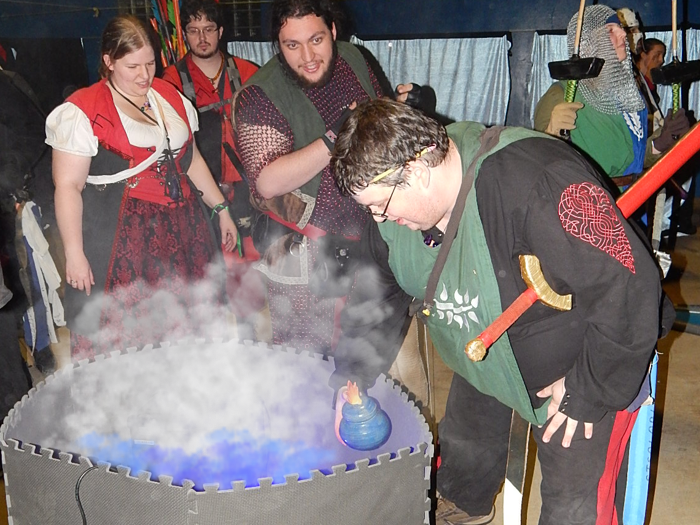 With the urns collected, Baern led the heroes to the seat of Surtr's power where the magical fire to bring him new life burned. In the highest parts of the palace was his brother, bearing the obsidian crown and commanding an army of faenfolk to attack the adventurers. Around the fire, salamanders wearing colored pendants wandered between six colored crystals on pedestals that matched the colors of the urns. By luring the salamanders to the correct crystals in the correct pattern the fire in the center of the room would change color. As the flame changed to the color of each urn, the vessel of ashes was thrown inside. Meanwhile, the heroes fight tooth and nail against Surtr's brother, and each time they were able to stun him they suffered incredible losses braving his terrible fists and fiery visage. But they were also, one by one, able to tear away the pieces of the crown from his head. When at last the last piece was removed from him, and he lay defeated on the ground, they were able to finish the ritual to give Surtr new life by throwing the shards of the crown into the fire.
With the urns collected, Baern led the heroes to the seat of Surtr's power where the magical fire to bring him new life burned. In the highest parts of the palace was his brother, bearing the obsidian crown and commanding an army of faenfolk to attack the adventurers. Around the fire, salamanders wearing colored pendants wandered between six colored crystals on pedestals that matched the colors of the urns. By luring the salamanders to the correct crystals in the correct pattern the fire in the center of the room would change color. As the flame changed to the color of each urn, the vessel of ashes was thrown inside. Meanwhile, the heroes fight tooth and nail against Surtr's brother, and each time they were able to stun him they suffered incredible losses braving his terrible fists and fiery visage. But they were also, one by one, able to tear away the pieces of the crown from his head. When at last the last piece was removed from him, and he lay defeated on the ground, they were able to finish the ritual to give Surtr new life by throwing the shards of the crown into the fire.
Suddenly a bright red light shone from the central fire. A voice boomed out. Surtur was in the process of being reborn but first he bellowed a warning to the adventurers. That any mortal that looked upon his true form would have their soul incinerated. With those words of caution the heroes of the Realms made haste back to the awaiting Vanfrost. They had been successful on their mission and one more broken part of Norlund had been made whole. But perhaps this latest adventure had created more questions than it had answered.
❧ The Gilded Lion Summer Festival III: Echoes of Ragnarok: Jotunheim, June 17, 1017
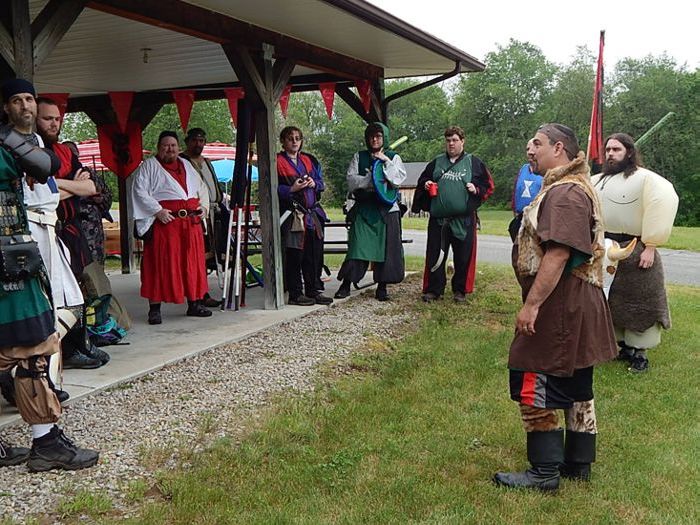 As had become expected at this time of year, the heroes of the Realms received a request for aid from their ally in Norlund, Ulric. As he had many times before, the leader of the Jomsvikings sought their aid in repairing the damage Bedlam had done to his world. Now, however, it was becoming clear that their task would involve more than just fixing what The Black Death brought. It would involve a fight against those who would stop the worlds of Norlund from being healed by opposing the plan to rekindle Ragnarok. In this case, their unknown enemy was found to be marshaling the aid of the largest and most fearsome creatures of Jotunheim, the land of giants. While Urlic was not sure just how these beasts would be used to further the evil plans of their masters, he knew that destroying them before they could be brought to bear against them was the wisest course of action. So he asked the heroes of the Realms to make a series of surgical strikes into Jotunheim and to wipe out as many of these gargantuan monsters as they were able.
As had become expected at this time of year, the heroes of the Realms received a request for aid from their ally in Norlund, Ulric. As he had many times before, the leader of the Jomsvikings sought their aid in repairing the damage Bedlam had done to his world. Now, however, it was becoming clear that their task would involve more than just fixing what The Black Death brought. It would involve a fight against those who would stop the worlds of Norlund from being healed by opposing the plan to rekindle Ragnarok. In this case, their unknown enemy was found to be marshaling the aid of the largest and most fearsome creatures of Jotunheim, the land of giants. While Urlic was not sure just how these beasts would be used to further the evil plans of their masters, he knew that destroying them before they could be brought to bear against them was the wisest course of action. So he asked the heroes of the Realms to make a series of surgical strikes into Jotunheim and to wipe out as many of these gargantuan monsters as they were able.
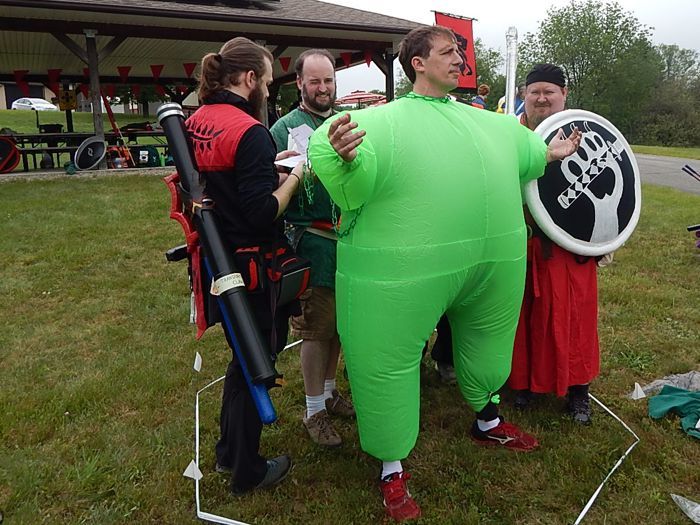 This was a task easier said than done, however. The massive beasts of Jotunheim were so mighty in their stature and their constitution that the blade of a mortal was effectively useless against them. Yet hope still remained. Ulric introduced the adventurers to Bors, a Jotun who would aid them by conferring upon them the body, the life, and the might of his giant peoples, through a ritual which would divide those powers between several mortals. As heroes donned the powers of the Jotun they became giants themselves. Towering over their peers, they were ready and able to take on the great beasts of Jotunheim with the magical support of the non-jotunized allies.
This was a task easier said than done, however. The massive beasts of Jotunheim were so mighty in their stature and their constitution that the blade of a mortal was effectively useless against them. Yet hope still remained. Ulric introduced the adventurers to Bors, a Jotun who would aid them by conferring upon them the body, the life, and the might of his giant peoples, through a ritual which would divide those powers between several mortals. As heroes donned the powers of the Jotun they became giants themselves. Towering over their peers, they were ready and able to take on the great beasts of Jotunheim with the magical support of the non-jotunized allies.
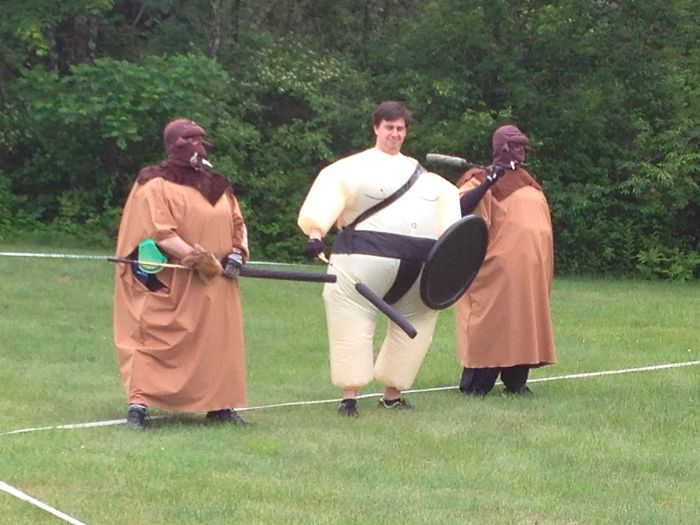 Ulric had prepared a map for the adventurers, showing them the lands of Jotunheim. It was a world ruled by magic consisting of four elements, ice, flame, earth, and lightning, and different areas of the landscape emitted the energies, and was refuge to the beasts, aligned to each of these. The leader of the Jomsvikings explained that they had found in each elemental areas a king beast that was mighty enough to resist the assault of the heroes even in their Jotun form. To be successful, he explained, the heroes would have to hunt beasts from other elements and forge out of their viscream teeth, horns, and scales weapons that would be more effective against these king beasts and armor that would turn their massive blows.
Ulric had prepared a map for the adventurers, showing them the lands of Jotunheim. It was a world ruled by magic consisting of four elements, ice, flame, earth, and lightning, and different areas of the landscape emitted the energies, and was refuge to the beasts, aligned to each of these. The leader of the Jomsvikings explained that they had found in each elemental areas a king beast that was mighty enough to resist the assault of the heroes even in their Jotun form. To be successful, he explained, the heroes would have to hunt beasts from other elements and forge out of their viscream teeth, horns, and scales weapons that would be more effective against these king beasts and armor that would turn their massive blows.
 The adventurers first sought out creatures of earth and as they knitted together armor and wove new magic spells aligned with that element they found themselves equal to the task of defeating the Sky Fish, a King beast of lightning. Defeating still more denizens of the lightning element, the heroes were then capable of striking down the Ice Whale. In this same fashion the Flame Dragon fell next to weapons and spells made of ice. Finally the Wyrm of Earth met it's doom at the hands of heroes wielding implements of fire. It was a long day of hunting their prey and crafting the tools of war. While the fighting wore on into the late afternoon, Loki's aid was secured via the mysterious chests he always sees fit to challenge the heroes with. Unlocking their mysteries provided the heroes with even more powerful spells to wield.
The adventurers first sought out creatures of earth and as they knitted together armor and wove new magic spells aligned with that element they found themselves equal to the task of defeating the Sky Fish, a King beast of lightning. Defeating still more denizens of the lightning element, the heroes were then capable of striking down the Ice Whale. In this same fashion the Flame Dragon fell next to weapons and spells made of ice. Finally the Wyrm of Earth met it's doom at the hands of heroes wielding implements of fire. It was a long day of hunting their prey and crafting the tools of war. While the fighting wore on into the late afternoon, Loki's aid was secured via the mysterious chests he always sees fit to challenge the heroes with. Unlocking their mysteries provided the heroes with even more powerful spells to wield.
Finally with each of the king beasts defeated, the final task set before the heroes was to seek out the mightiest of the creatures recruited into the army of their enemy, the Chimera of the Four Elements. Fighting this massive, four-headed beast was no easy task. It required the coordination of many heroes that had taken on the form of Jotun, each equipped to deal with a different elemental head of the monster. As lightning and fireballs and rains of acid filled the battlefield, the adventurers' swords struck their, their shields held fast, and their magic tore through wing and claw. In the end, the Chimera of the Four Elements lay defeated and the heroes of the Realms had once more foiled the plans of their mysterious enemy who sought to end their bid for the holy war of Ragnarok.
❧ Echoes of Ragnarok III: Helheim, November 4, 1017
The time had come once again for Ulric of the Jomsvikings to pen a missive to the heroes of the Realms. Once again, through communing with the remaining gods, he and his people were able to learn of another wrong that need be righted in order to heal Norlund and begin Ragnarok as the legends foretold. The Jomsvikings had learned that the goddess Hel was under siege in her own domain, some of her generals having turned traitor and marshaled their armies together to oppose her. There could be little doubt that the force that opposed Ragnarok from occurring had somehow gained influence over parts of Hel’s army and had left her in a most dire position.
Responding well to their ally’s summons, the heroes of the Realms met Ulric on the steps of Helheim where he instructed them as to their task. There was no way a small band of even the mightiest heroes could hope to defeat the entire army opposing Hel, but by going on a series of covert missions to places that were determined to be enemy staging grounds and sources of strength, smaller numbers of warriors could be effective in weakening this massive force and turning the overall tide of battle in the empress of the dead’s favor. Briefed on the first of such operations, the adventurers hurried off to fulfil their duty.
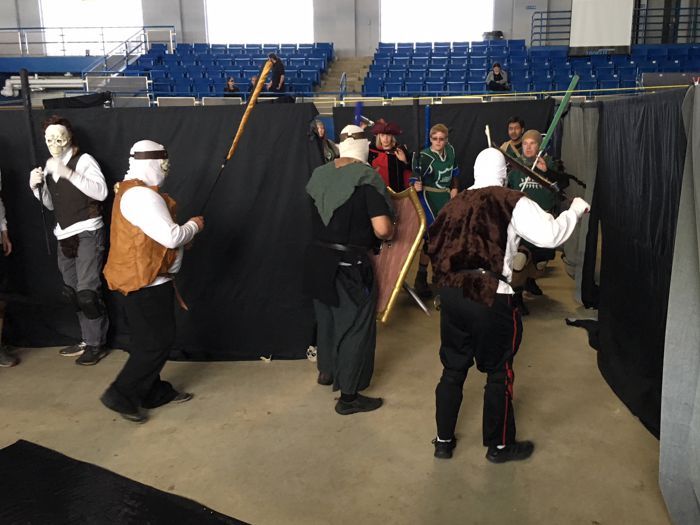 As was to be expected, fighting their way through the barren hellscape was no easy task. The undead that opposed the heroes were strong and the heroes quickly learned that there was a miasma of dishonor that hung over all of them that made them weaker, restricted their access to spells and armor, and made taking every step a battle in and of itself. There were, however, methods to relieve those burdens. Killing the undead who opposed them allowed the heroes to gain honor which gave them the strength to slough off some of the restrictions put upon them by the environment. Also, some heroes began to gather small bones that they found on their adversaries and assemble them into powerful totems called fetishes which unlocked even greater powers.
As was to be expected, fighting their way through the barren hellscape was no easy task. The undead that opposed the heroes were strong and the heroes quickly learned that there was a miasma of dishonor that hung over all of them that made them weaker, restricted their access to spells and armor, and made taking every step a battle in and of itself. There were, however, methods to relieve those burdens. Killing the undead who opposed them allowed the heroes to gain honor which gave them the strength to slough off some of the restrictions put upon them by the environment. Also, some heroes began to gather small bones that they found on their adversaries and assemble them into powerful totems called fetishes which unlocked even greater powers.
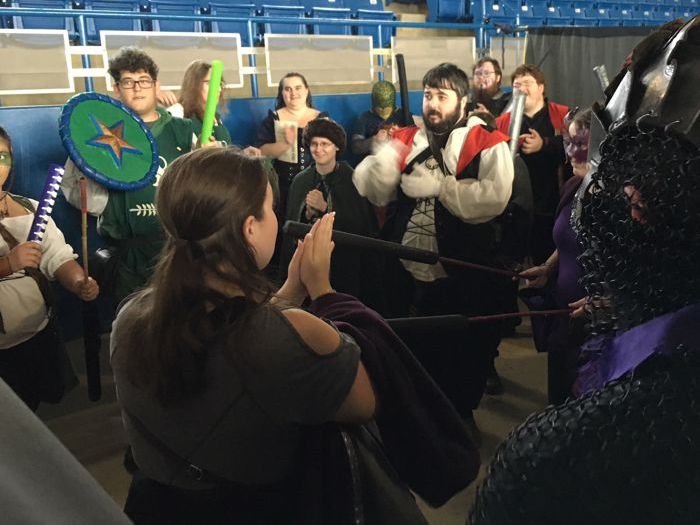 It wasn’t long until the heroes came up against a heavy door that they could not budge. There were letters and symbols scrawled across its stone face and it wasn’t long until the adventurers realized that they had already found the tools they needed to open the way forward. The door would throw itself open if the correct notes were played, and they had found a set of hollow spines that, when struck, would emit those correct tones. As they progressed further and further through the caverns of Helheim more of these musical bones were found and the puzzles that locked the doors become more complex. The heroes also came across cloth dolls completely blank of any features, as well as clearly enchanted tools which could be used to decorate them. Through divination they learned that creating cloth replicas of themselves was the key to escaping Hel’s domain once their tasks there were done.
It wasn’t long until the heroes came up against a heavy door that they could not budge. There were letters and symbols scrawled across its stone face and it wasn’t long until the adventurers realized that they had already found the tools they needed to open the way forward. The door would throw itself open if the correct notes were played, and they had found a set of hollow spines that, when struck, would emit those correct tones. As they progressed further and further through the caverns of Helheim more of these musical bones were found and the puzzles that locked the doors become more complex. The heroes also came across cloth dolls completely blank of any features, as well as clearly enchanted tools which could be used to decorate them. Through divination they learned that creating cloth replicas of themselves was the key to escaping Hel’s domain once their tasks there were done.
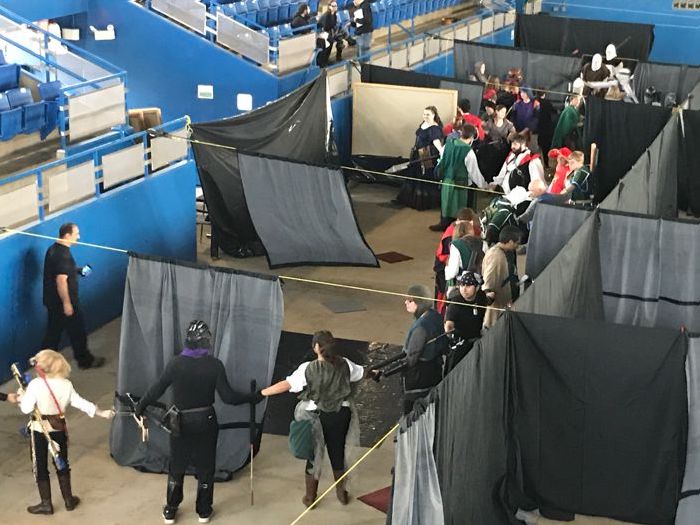 The adventurers soon came across a set of tunnels where the winds were so strong that they could not push themselves to walk against them. These winds of the dead would have stopped them in their tracks forever but for mysterious floor panels that seemed to somehow make those standing on them immune to the gusts. To make use of the few panels that existed, the heroes were forced to link arms, pulling themselves person by person from one panel to the next as they made it through the tunnels and out of the influence of the devastating gales.
The adventurers soon came across a set of tunnels where the winds were so strong that they could not push themselves to walk against them. These winds of the dead would have stopped them in their tracks forever but for mysterious floor panels that seemed to somehow make those standing on them immune to the gusts. To make use of the few panels that existed, the heroes were forced to link arms, pulling themselves person by person from one panel to the next as they made it through the tunnels and out of the influence of the devastating gales.
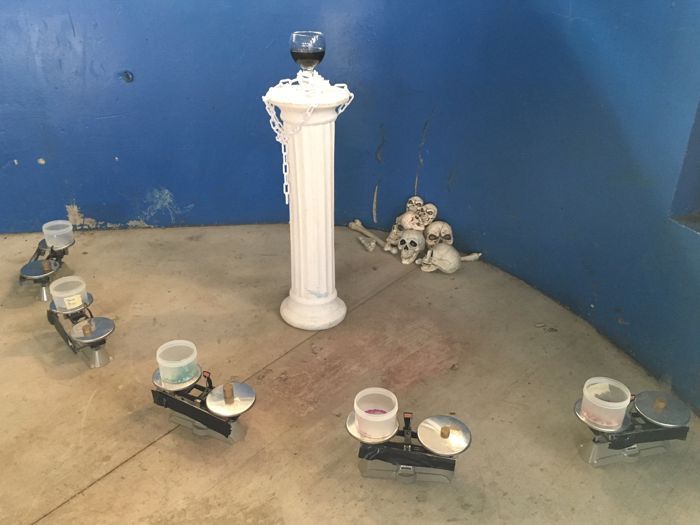 Deep in one of the caverns, at the first enemy staging area, the heroes saw a pedestal and upon it a large goblet of dark liquid. It was somewhat clear that whatever lay in that vessel was a source of power for the enemy and as if to confirm that suspicion, the undead that opposed them seemed to be, more and more, covered with dark splotches and wielding more devastating abilities. Yet the goblet was locked down with ghostly chains and surrounded by scales filled with colored rocks. Nearby was a giant pit of sand in which great worms undulated. The heroes realized that from that sand pit they had to sift out colored rocks to balance the scales. While some battled the worms and kept them at bay, others dug through the dirt in order to find the gems that they needed. When all of the scales were balanced, the chain fell away and the heroes dashed the goblet of black liquid to the ground. Their first mission was a successful one.
Deep in one of the caverns, at the first enemy staging area, the heroes saw a pedestal and upon it a large goblet of dark liquid. It was somewhat clear that whatever lay in that vessel was a source of power for the enemy and as if to confirm that suspicion, the undead that opposed them seemed to be, more and more, covered with dark splotches and wielding more devastating abilities. Yet the goblet was locked down with ghostly chains and surrounded by scales filled with colored rocks. Nearby was a giant pit of sand in which great worms undulated. The heroes realized that from that sand pit they had to sift out colored rocks to balance the scales. While some battled the worms and kept them at bay, others dug through the dirt in order to find the gems that they needed. When all of the scales were balanced, the chain fell away and the heroes dashed the goblet of black liquid to the ground. Their first mission was a successful one.
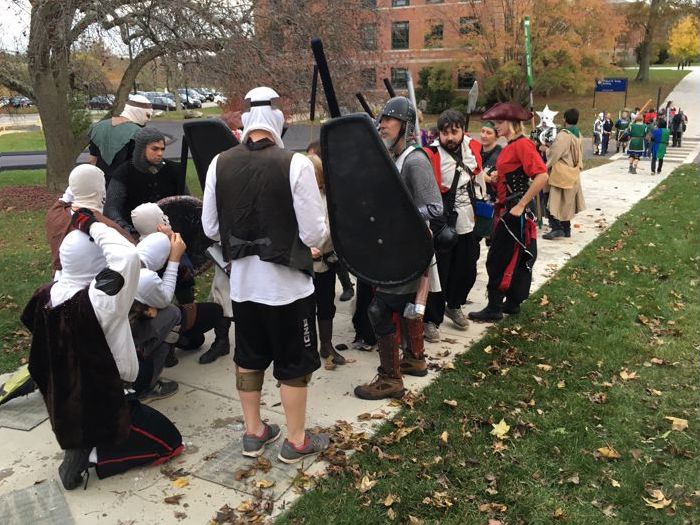 When the heroes returned to their own staging area they found a missive waiting for them scrolled onto the walls of the cavern. They needed next to proceed to a bridge that lay over the chasm of lost souls and fight their way across that bridge past an endless horde of undead. Luckily the missive, left by another group of Hel’s operatives, contained the instructions for creating an ice spell that, when shaped into a missile, could be used to freeze the skeletons in place, activating switches that could open the way forward on the bridge. It was a long fight as the heroes slowly advanced, cutting down their enemies, timing their throws so that the undead would be stopped just as they activated the mechanisms. They did reach the end of the bridge eventually, however, and after doing so were able to empty the next goblet of dark liquid.
When the heroes returned to their own staging area they found a missive waiting for them scrolled onto the walls of the cavern. They needed next to proceed to a bridge that lay over the chasm of lost souls and fight their way across that bridge past an endless horde of undead. Luckily the missive, left by another group of Hel’s operatives, contained the instructions for creating an ice spell that, when shaped into a missile, could be used to freeze the skeletons in place, activating switches that could open the way forward on the bridge. It was a long fight as the heroes slowly advanced, cutting down their enemies, timing their throws so that the undead would be stopped just as they activated the mechanisms. They did reach the end of the bridge eventually, however, and after doing so were able to empty the next goblet of dark liquid.
As the heroes returned to their staging area they found that the other covert team of Hel’s agents had left them both a meal to lift their spirits and a locked chest that surly contained something that they would desperately need. The heroes ate while they continued to work on their cloth replicas and tried to complete the complex musical puzzle that kept the chest locked.
 Only one enemy staging area remained. The heroes fought their way through increasingly more powerful, increasingly darkened undead. Tunnel after tunnel and cavern after cavern, eventually they came to a place where ghostly apparitions bubbled out of pits at their feet. Instructed by yet another missive from Hel’s agents, the heroes knew that these souls of the damned would need to be moved to their final resting place and in doing so, the chain that was set around the last of the vessels of black ichor would be undone. Scooping up the soul material with hands and shields and cloaks the heroes brought the bubbling whiteness to a pit that lie on the other side of the room near the goblet. When finally the pit was full the chain fell away and the dark liquid was again disposed of.
Only one enemy staging area remained. The heroes fought their way through increasingly more powerful, increasingly darkened undead. Tunnel after tunnel and cavern after cavern, eventually they came to a place where ghostly apparitions bubbled out of pits at their feet. Instructed by yet another missive from Hel’s agents, the heroes knew that these souls of the damned would need to be moved to their final resting place and in doing so, the chain that was set around the last of the vessels of black ichor would be undone. Scooping up the soul material with hands and shields and cloaks the heroes brought the bubbling whiteness to a pit that lie on the other side of the room near the goblet. When finally the pit was full the chain fell away and the dark liquid was again disposed of.
Returning once again to their staging area, the heroes finally unlocked the chest left to them by Hel’s agents. From the missive locked inside they were told that in the deepest areas behind enemy lines there lay a secret lab. In this laboratory evil experiments were being done that resulted in the black liquid which gave the minions of the traitorous generals so much power. The agents of Hel were eliminated to all but a couple men in but in doing so were able to gather together the reagents necessary to ruin the experiments determine how to raize the laboratory to the ground. Armed with these reagents and the knowledge of what they had to do, the adventurers boldly fought their way forward until they found a room full of vials and flasks, benches and tables, bones and many, many containers of the black liquid they had seen all day. And something else. A giant tank and suspended within it some sort of creature.
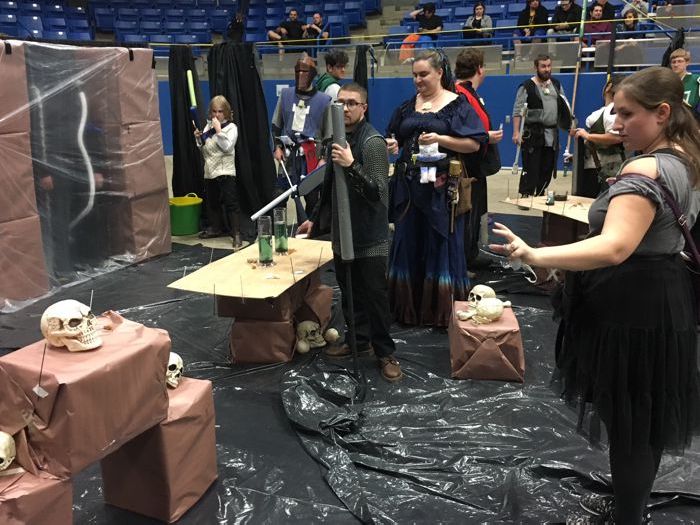 It took a few moments for recognition to hit, and only a split second after that for the adventuring party to be struck by pure terror. Fixated in that tank, hooked up to wires and tubes and seemingly unable to move due to the dagger that impaled it, was a Bedlam Bois. The pieces fell into place quickly after that. Somehow the generals had been able to capture one of these horrible creatures alive and had suspended it in time in order to perform experiments on it. When the rest of “the black death” disappeared from Norlund, this specimen did not, so frozen it was in stasis. The dark ichor that was fueling the army that stood against Hel was using the power of Bedlam to make itself a more fearsome adversary than anyone could have expected.
It took a few moments for recognition to hit, and only a split second after that for the adventuring party to be struck by pure terror. Fixated in that tank, hooked up to wires and tubes and seemingly unable to move due to the dagger that impaled it, was a Bedlam Bois. The pieces fell into place quickly after that. Somehow the generals had been able to capture one of these horrible creatures alive and had suspended it in time in order to perform experiments on it. When the rest of “the black death” disappeared from Norlund, this specimen did not, so frozen it was in stasis. The dark ichor that was fueling the army that stood against Hel was using the power of Bedlam to make itself a more fearsome adversary than anyone could have expected.
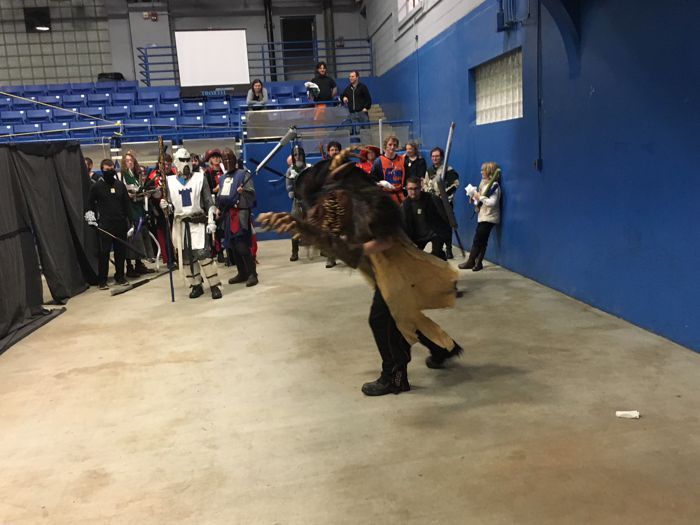 It was with righteous fury, then, that the heroes of the Realms followed the instructions written to them by Hel’s agents. They ruined each experiment with the correct reagents. They set fire to the different parts of the laboratory equipment in the correct order, and then they tore everything; every table and bench, every bone and every vial, apart with their bare hands, stomped it to dust beneath their heels, and made sure that nothing could ever be made with such horrible powers ever again. The Bois, having been released of its stasis with the destruction of the lab, faded into oblivion, leaving nothing behind.
It was with righteous fury, then, that the heroes of the Realms followed the instructions written to them by Hel’s agents. They ruined each experiment with the correct reagents. They set fire to the different parts of the laboratory equipment in the correct order, and then they tore everything; every table and bench, every bone and every vial, apart with their bare hands, stomped it to dust beneath their heels, and made sure that nothing could ever be made with such horrible powers ever again. The Bois, having been released of its stasis with the destruction of the lab, faded into oblivion, leaving nothing behind.
And so the heroes had succeeded at their task. The armies that opposed Hel were in tatters and robbed of their power. Yet the task that still remained in front of them was to escape the domain of the very goddess that they had come there to aid. Fortunate that they had been preparing for that eventuality all along. As they walked to the place where they could escape Helheim through the branches of Yggdrasil the guardian of that doorway stood before them; the son of Fenrir. This gigantic demonic wolf was tasked with not letting a single soul slip by him, but he was easily fooled by the cloth doppelgangers that the heroes had worked so hard to construct. One by one, the adventurers diverted the monster’s attention with their dolls, and one by one they slipped away back home.
❧ The Gilded Lion Summer Festival IV: Echoes of Ragnarok: Midgard, June 23, 1018
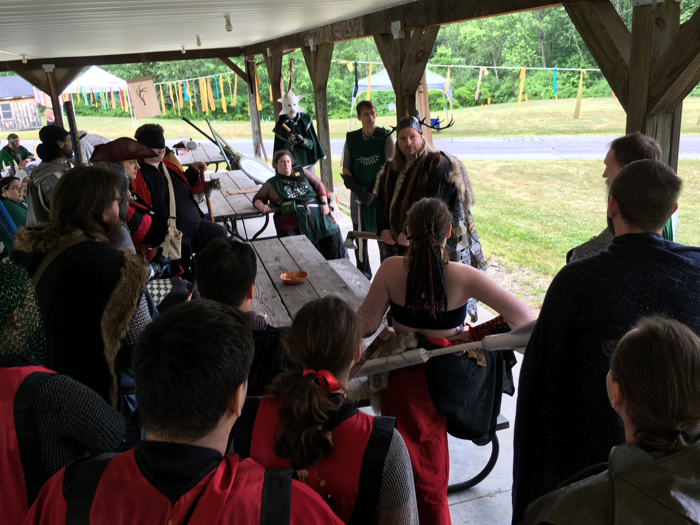 It was a dreary day in early summer when the heroes of the Realms arrived in Midgard. A light drizzle through the morning cast what was supposed to be a celebratory day in grim contrast to the actual fate of the world they found themselves in. The adventurers had arrived over the Vanfrost not heeding the call of their usual compatriot Ulirc the Jomsviking. Instead, they were summoned to meet and to learn the motivations of someone declared to be his enemy. Jarl Thorafin, leader of the Western Peninsula.
It was a dreary day in early summer when the heroes of the Realms arrived in Midgard. A light drizzle through the morning cast what was supposed to be a celebratory day in grim contrast to the actual fate of the world they found themselves in. The adventurers had arrived over the Vanfrost not heeding the call of their usual compatriot Ulirc the Jomsviking. Instead, they were summoned to meet and to learn the motivations of someone declared to be his enemy. Jarl Thorafin, leader of the Western Peninsula.
 The adventurers were eager to hopefully have some questions answered. What was Jarl Thorafin’s plan? Why was he resisting Ragnarok? Was Norlund truly beyond saving - was reigniting Ragnarok the right choice? All these questions weighed heavily upon the hearts of the adventurers as Jarl Thorafin, their host for the day, introduced himself. Thorafin announced that he would not just explain himself with words - rather, he was going to use the celebration held that day to demonstrate just how alive Midgard (and by extension, Norlund) was. To this end, there would be contests between those loyal to the Jarl and the adventurers, and meals fit for heroes throughout the day. The winner of each competition would receive wooden runes - a small trinket, to indicate their success. Bragging rights, more than anything.
The adventurers were eager to hopefully have some questions answered. What was Jarl Thorafin’s plan? Why was he resisting Ragnarok? Was Norlund truly beyond saving - was reigniting Ragnarok the right choice? All these questions weighed heavily upon the hearts of the adventurers as Jarl Thorafin, their host for the day, introduced himself. Thorafin announced that he would not just explain himself with words - rather, he was going to use the celebration held that day to demonstrate just how alive Midgard (and by extension, Norlund) was. To this end, there would be contests between those loyal to the Jarl and the adventurers, and meals fit for heroes throughout the day. The winner of each competition would receive wooden runes - a small trinket, to indicate their success. Bragging rights, more than anything.
For lunch, Jarl Thorafin provided a hearty meal of chicken wings, ribs, and grilled corn. Jarl Thorafin emphasized the his point through the festivities: how could a dying world provide for such a bountiful feast?
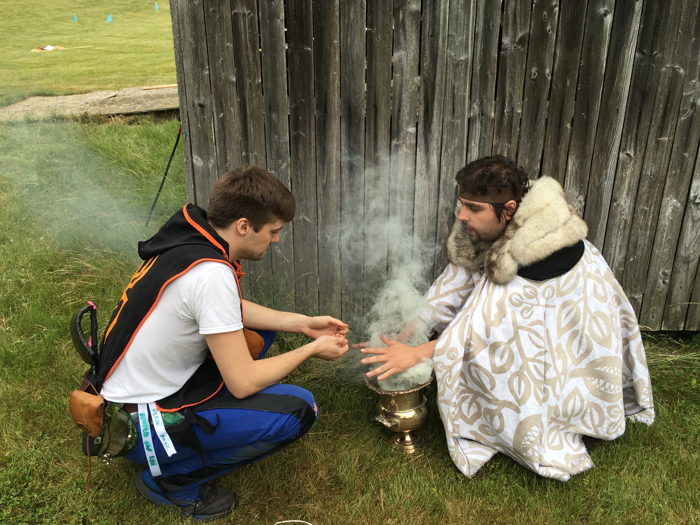 The adventurers competed throughout the day in various games, ranging from the board game Hnefatafl to the athletic game of Knattleikr, winning the aforementioned runes throughout the day. However, the adventurers would soon learn that these runes were more than mere trinkets. Those who proved themselves trustworthy were soon contacted by Priest Aros - a priest of Mimir, god of secrets, disguised as a member of Jarl Thorafin’s court. Priest Aros explained that his order had been wiped out by Jarl Thorafin; the temple had been looted. The runes were in fact usable by Aros in a ritual to contact Mimir, who could then relay secrets of Norlund to the word.
The adventurers competed throughout the day in various games, ranging from the board game Hnefatafl to the athletic game of Knattleikr, winning the aforementioned runes throughout the day. However, the adventurers would soon learn that these runes were more than mere trinkets. Those who proved themselves trustworthy were soon contacted by Priest Aros - a priest of Mimir, god of secrets, disguised as a member of Jarl Thorafin’s court. Priest Aros explained that his order had been wiped out by Jarl Thorafin; the temple had been looted. The runes were in fact usable by Aros in a ritual to contact Mimir, who could then relay secrets of Norlund to the word.
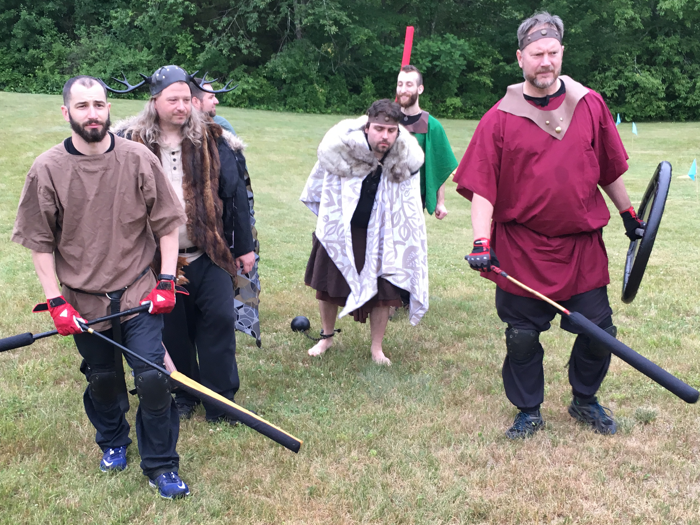 These secrets were earth shattering, ranging from “The fires of Muspelheim fade,” to “Norlund is a dead world in its death throes.” The exact message of each revelation was different, but the overall theme was the same. Norlund was as a candle burning out its wick, with no energy left to rekindle the cycle of life and death, and Ragnarok was a way to fix this. Before more revelations could come to light, however, Priest Aros was discovered by the Jarl’s men. He was brought out in chains before the adventurers. Jarl Thorafin accused the adventurers of treachery, had Aros executed, and banished the players back to the Realms.
These secrets were earth shattering, ranging from “The fires of Muspelheim fade,” to “Norlund is a dead world in its death throes.” The exact message of each revelation was different, but the overall theme was the same. Norlund was as a candle burning out its wick, with no energy left to rekindle the cycle of life and death, and Ragnarok was a way to fix this. Before more revelations could come to light, however, Priest Aros was discovered by the Jarl’s men. He was brought out in chains before the adventurers. Jarl Thorafin accused the adventurers of treachery, had Aros executed, and banished the players back to the Realms.
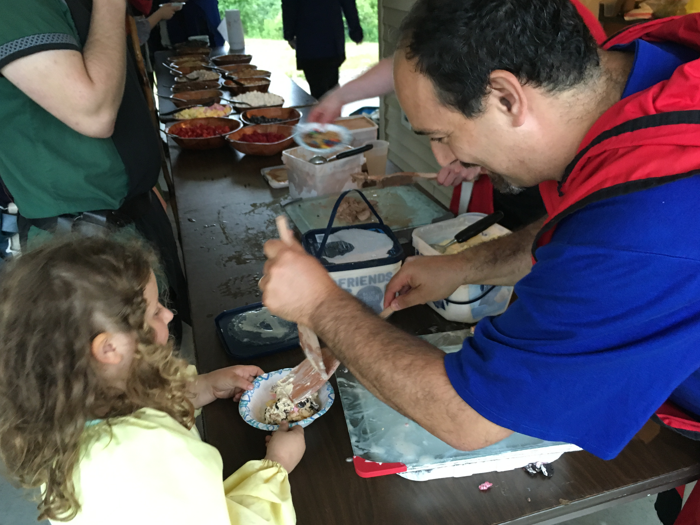 Once back in Rhiassa, the heroes were welcomed back to a dinner of custom made burritos, built right in front of them using ingredients they selected. While there was business to be discussed, Lord Aeston and Lord Gwen insisted that the adventurers continue to relax for a bit, and celebrate their victories from that day. To this end, they introduced the adventurers to their newest venture - Coldspring Creamery. For dessert, the adventurers were able to select a number of mix ins and a flavor of ice cream, and have a custom mixed ice cream dessert made right in front of them. With that, the Summer Festival came to an end, and the adventurers made their way home.
Once back in Rhiassa, the heroes were welcomed back to a dinner of custom made burritos, built right in front of them using ingredients they selected. While there was business to be discussed, Lord Aeston and Lord Gwen insisted that the adventurers continue to relax for a bit, and celebrate their victories from that day. To this end, they introduced the adventurers to their newest venture - Coldspring Creamery. For dessert, the adventurers were able to select a number of mix ins and a flavor of ice cream, and have a custom mixed ice cream dessert made right in front of them. With that, the Summer Festival came to an end, and the adventurers made their way home.
Despite the hostile actions of Jarl Thorafin and the revelations of Mimir, the adventurers of the Realms did not return home with clear answers. They looked to Jarl Thorafin and his followers, and saw a people that had carved out a life for themselves in this supposedly dead world. Every step of the way to reigniting Ragnarok, the adventurers had faced these warriors and their allies. These men and women had shown both courage and a strong will to live - strong enough to defy fate itself. As such, for several adventurers, the path was clear - they would save Norlund from it’s own cycle of death and rebirth.
❧ Echoes of Ragnarok Legends, July 13, 1018
Every land has it’s tales of heroes - individuals who accomplished great deeds in their lifetimes. Midgard is no exception, and one of their legends revolves around a man named Sigurd. Sigurd was a great warrior, most known for the slaying of the evil dragon Fafnir. After his great deed, however, Sigurd was not to live an easy life - having taken a cursed ring from the slain beast, the hero doomed himself to a tragic end. In a fit of arrogance and greed, Sigurd attempted to strike Odin himself. His sword was shattered, and his own warriors turned on him for his transgression. He was sealed away using Odin’s magic, entombed with the cursed ring that he would not release even in death.
This tomb sat undisturbed for hundreds of years. However, with the devastation wrought by the Black Death, Norlund is a changed place - and so to have it’s people changed. Gunnar Bjornson, descendant of Sigurd himself, was one such man. Gunnar had decided he would reforge Sigurd’s shattered sword, open the tomb, and reclaim the ring for himself. He would use this power to remake the world to his liking, trampling those who opposed him under his heel. Ulric of the Jomsvikings, who had been allied with Gunnar in the past, heard of the plot, and called on the adventurers of the Realms once more. Ulric asked the adventurers to carry out a grave task: find the cursed ring, and either destroy it or use its power to a more noble end.
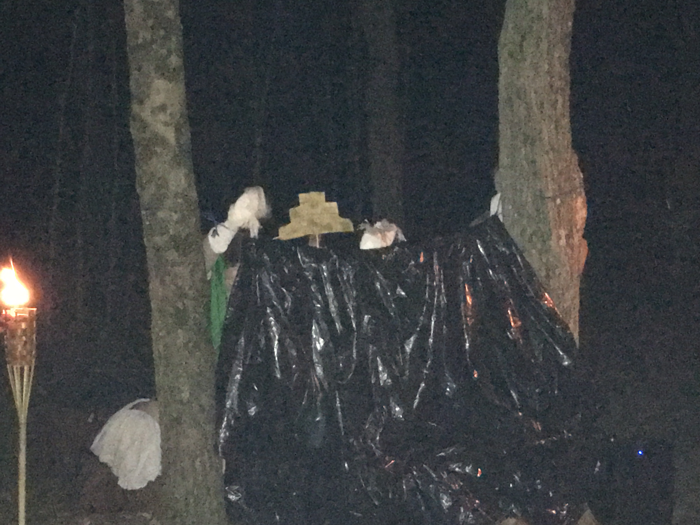 The adventurers met Ulric and his compatriots in their camp near the tomb on a clear night. It was customary on the anniversary of his death to retell the tale of Sigurd and celebrate his life and death through traditional games. The Jomsvikings reenacted Sigurd's life through a puppet show and between each act the visiting heroes participated in a game that symbolized that part of the tale. The heroes also learned about their task for the next day. When Sigurd struck Odin and shattered his sword, some of the Allfather’s essence was absorbed by it in the process. The vikings who killed and entombed sigurd made that shattered sword the key to his tomb. The next day would be a race between the adventurers and the traitorous Gunnar to see who could assemble the sword first.
The adventurers met Ulric and his compatriots in their camp near the tomb on a clear night. It was customary on the anniversary of his death to retell the tale of Sigurd and celebrate his life and death through traditional games. The Jomsvikings reenacted Sigurd's life through a puppet show and between each act the visiting heroes participated in a game that symbolized that part of the tale. The heroes also learned about their task for the next day. When Sigurd struck Odin and shattered his sword, some of the Allfather’s essence was absorbed by it in the process. The vikings who killed and entombed sigurd made that shattered sword the key to his tomb. The next day would be a race between the adventurers and the traitorous Gunnar to see who could assemble the sword first.
 Fortunately the ancient vikings had laid clues for those clever enough to solve them so that the pieces could be found. By combining their wits and magic, the adventurers were able to solve the puzzles and claim several pieces of the sword. Gunnar, for his own part, had collected a few of the pieces as well. By the end of the day, inevitably, a confrontation took place between the two sides. At the end of the battle, Gunnar Bjornson laid dead - his life cut short, by his greed, like his ancestor before him - and the adventurers had all the parts of the ancient blade.
Fortunately the ancient vikings had laid clues for those clever enough to solve them so that the pieces could be found. By combining their wits and magic, the adventurers were able to solve the puzzles and claim several pieces of the sword. Gunnar, for his own part, had collected a few of the pieces as well. By the end of the day, inevitably, a confrontation took place between the two sides. At the end of the battle, Gunnar Bjornson laid dead - his life cut short, by his greed, like his ancestor before him - and the adventurers had all the parts of the ancient blade.
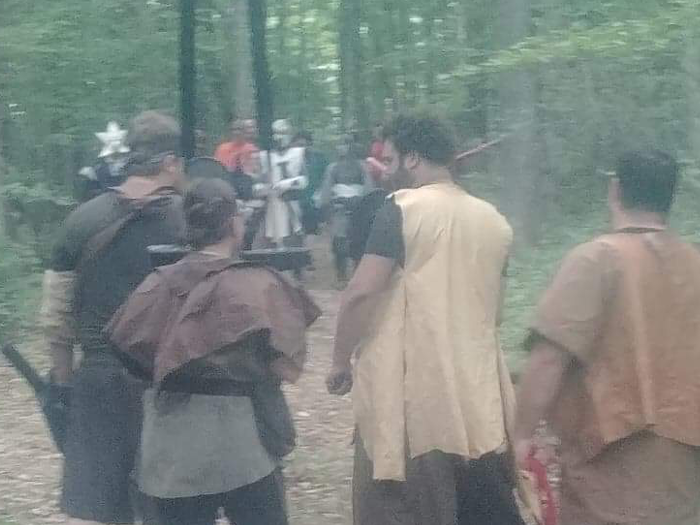 The heroes of the Realms were able to reforge the sword using their own might and magic and with that, the tomb could be opened. At nightfall, under the proper alignment of the stars, the adventurers stepped into the final resting place of Sigurd. Earlier in the day, they had learned that several runes were associated with specific colors. They used this knowledge to unlock the tombs doors - ingenious puzzles, designed by the same vikings who hid the sword fragments in the first place. They knew that in order to be victorious they must cleanse the tomb of corruption, the puzzles themselves were ancient conduits of power and by completing them they were able to use Odin’s essence from the sword to accomplish that task.
The heroes of the Realms were able to reforge the sword using their own might and magic and with that, the tomb could be opened. At nightfall, under the proper alignment of the stars, the adventurers stepped into the final resting place of Sigurd. Earlier in the day, they had learned that several runes were associated with specific colors. They used this knowledge to unlock the tombs doors - ingenious puzzles, designed by the same vikings who hid the sword fragments in the first place. They knew that in order to be victorious they must cleanse the tomb of corruption, the puzzles themselves were ancient conduits of power and by completing them they were able to use Odin’s essence from the sword to accomplish that task.
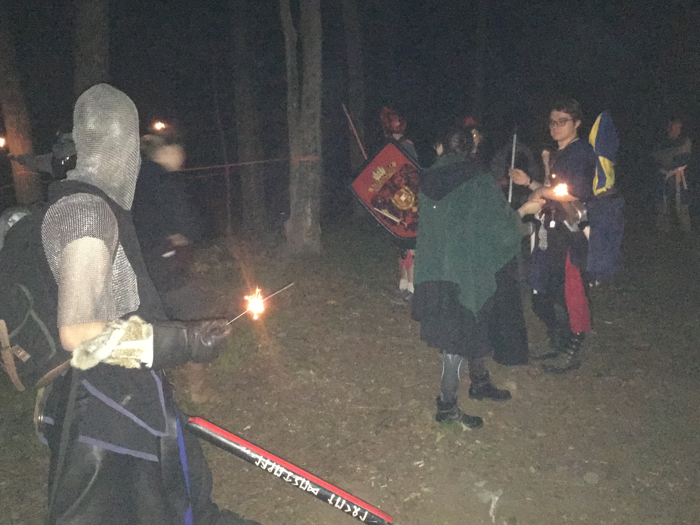 As the adventurers delved deeper into the tomb, they heard strange noises. Unnatural growls and roars bellowed from Sigurd’s chamber. When the heroes did reach the final part of the tomb, they found a giant undead dragon before them, the corrupted, twisted form of Sigurd, himself. It would seem that not even in death could the legendary hero escape the ring’s curse. Dodging rays of necrotic energy that shone forth from the dragon’s eyes and the noxious fumes that it exhaled, several adventurers made their way to the dragon and began fighting it. Eventually, they realized that it could not be killed from the outside, and began madly tearing at the dragon’s flesh. After hacking their way through sinew and muscle, arteries and veins, they found the beast’s heart. They tore it out of the beast, and destroyed it, finally putting an end to Sigurd’s woeful existence.
As the adventurers delved deeper into the tomb, they heard strange noises. Unnatural growls and roars bellowed from Sigurd’s chamber. When the heroes did reach the final part of the tomb, they found a giant undead dragon before them, the corrupted, twisted form of Sigurd, himself. It would seem that not even in death could the legendary hero escape the ring’s curse. Dodging rays of necrotic energy that shone forth from the dragon’s eyes and the noxious fumes that it exhaled, several adventurers made their way to the dragon and began fighting it. Eventually, they realized that it could not be killed from the outside, and began madly tearing at the dragon’s flesh. After hacking their way through sinew and muscle, arteries and veins, they found the beast’s heart. They tore it out of the beast, and destroyed it, finally putting an end to Sigurd’s woeful existence.
 While destroying the heart the adventures found the cursed ring that had defined so much of Sigurd’s life and death. They brought the ring back to their camp, and faced a dilemma. They learned they could potentially use Sigurd’s sword, still imbued with Odin’s essence, to purify the ring, creating an object of great power that would certainly aid them in restarting Ragnarok. In the process, however, Odin’s essence would be lost. Alternately, they could use the sword to destroy the ring. The sword would be unharmed and Sigurd’s sin purified from it; while the cursed ring would finally be destroyed, any chance of using the ring for Ragnarok would be lost.
While destroying the heart the adventures found the cursed ring that had defined so much of Sigurd’s life and death. They brought the ring back to their camp, and faced a dilemma. They learned they could potentially use Sigurd’s sword, still imbued with Odin’s essence, to purify the ring, creating an object of great power that would certainly aid them in restarting Ragnarok. In the process, however, Odin’s essence would be lost. Alternately, they could use the sword to destroy the ring. The sword would be unharmed and Sigurd’s sin purified from it; while the cursed ring would finally be destroyed, any chance of using the ring for Ragnarok would be lost.
The discussion was short. The adventurers remembered the resolve they had seen from the inhabitants of Midgard. They met men and women who would fight and die for what was clearly a fading world, those who would do all they could to defy fate itself. The heroes decided to destroy the ring, and try to use what remained of the Allfather’s essence to rebuild Norlund without first destroying it in Ragnarok. In forging Sigurd’s sword, the adventurers had also forged a new legend, one that would surely be passed down for generations. However, such sagas need a great heros as well. And who would be a better hero than the man who led the Jomsvikings, showing a strength of will that few other possessed? The adventurers handed Ulric Sigurd’s sword, and insisted that he destroy the cursed ring - that he be the first new legendary figure of Norlund. With that, Ulric swung the blade, destroyed the cursed ring, and began a new chapter in Norlund’s fate.
❧ Echoes of Ragnarok IV: Mane, December 8, 1018
The heroes of the Realms, committed to the idea that there must be a way to repair the broken worlds of Norlund without first triggering the catastrophe of Ragnarok, realized that to start gathering the information they needed to act upon it was necessary for them to go to Asgard itself and ascertain the state of its denizens. Unfortunately with both the Bifrost and Yggdrissal itself completely impassable, they had to find a different way to the realm of the gods.
Ulric, committed to his pledge to help the heroes in their new mission, set his people to examining the ancient lore and in doing so found a chance at success. When Ragnarok began, as was foretold, the moon and the sun stopped their travel the sky. During the ensuing invasion of and war with The Black Death, the Gods that pulled them through the heavens with their chariots, Mane and Sol, were obliterated. Since that time neither of the stellar objects had moved, but when they once did, Ulric learned, they occasionally touched the firmament of Asgard and Midgard, both. If the heroes of the Realms could somehow stirr the moon out of its dormancy, they could perhaps use it as a mode of transportation to reach their destination.
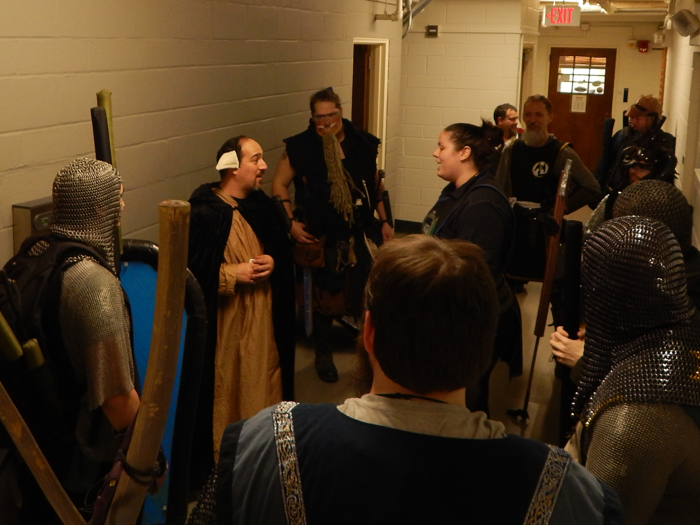 Urlic also knew that traversing the skies was well beyond help that he and his Jomsvikings might provide, but suspected there were others that might be of more aid. Knowing that the elves of Alvheim wielded such magic and technology to have created airships to take to the skies, Ulric recruited the services of an elven shipwright named Llwellen that the heroes might gain access to one of these magical vessels. Llwellen was honored to be of service in such an important task, and met the heroes on that late Autumn day to advise and guide them. Llwellwen explained that Mane, before it was towed across the sky by the god of the same name, was built and made mobile by the magic and technology of the elves. It might be possible, therefore, to resurrect that ancient machinery and thus once again propel the moon through the heavens.
Urlic also knew that traversing the skies was well beyond help that he and his Jomsvikings might provide, but suspected there were others that might be of more aid. Knowing that the elves of Alvheim wielded such magic and technology to have created airships to take to the skies, Ulric recruited the services of an elven shipwright named Llwellen that the heroes might gain access to one of these magical vessels. Llwellen was honored to be of service in such an important task, and met the heroes on that late Autumn day to advise and guide them. Llwellwen explained that Mane, before it was towed across the sky by the god of the same name, was built and made mobile by the magic and technology of the elves. It might be possible, therefore, to resurrect that ancient machinery and thus once again propel the moon through the heavens.
So it was to the Moon that the adventurers were bound. It was an unfortunate reality, however, that the airships of Alvheim were all but obliterated in the war with the Black Death and the population of shipwrights, craftsmen, and artificers that created them were mostly eliminated as well. As fate would have it, however, there was a single unfinished vessel that lied in the dock, unable to be completed as the war waged on. Llwellen said he would gift it to the adventurers should they only give it the last of the magic it needed in order to fly. Floatsones, the flower of an arcane plant that the elves cultivate in their magical gardens.
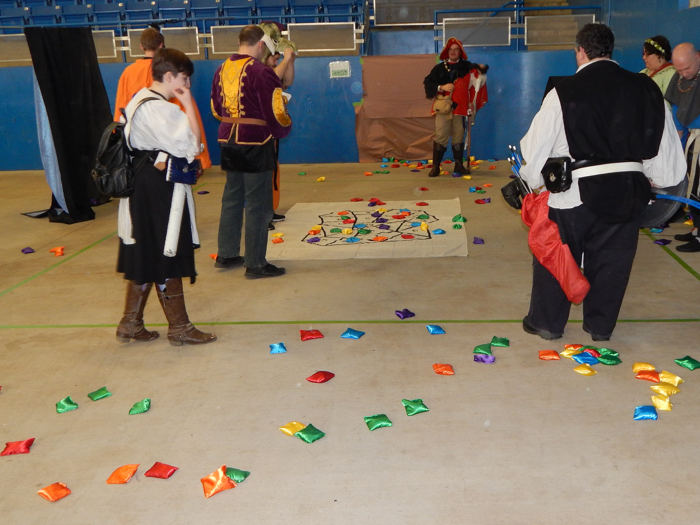 The heroes of the Realms entered such a garden and found but a few lone elves laboriously attempting tasks that helped generate the resources that the plants required. Yet so few were they and so weakened in the wake of the Black Death’s invasion, there was little they could do. The adventurers, however, took to the cultivation of the plants and in short order completed enough of them that they quickly grew the five floatstones that were required to imbue the ship with the power of flight.
The heroes of the Realms entered such a garden and found but a few lone elves laboriously attempting tasks that helped generate the resources that the plants required. Yet so few were they and so weakened in the wake of the Black Death’s invasion, there was little they could do. The adventurers, however, took to the cultivation of the plants and in short order completed enough of them that they quickly grew the five floatstones that were required to imbue the ship with the power of flight.
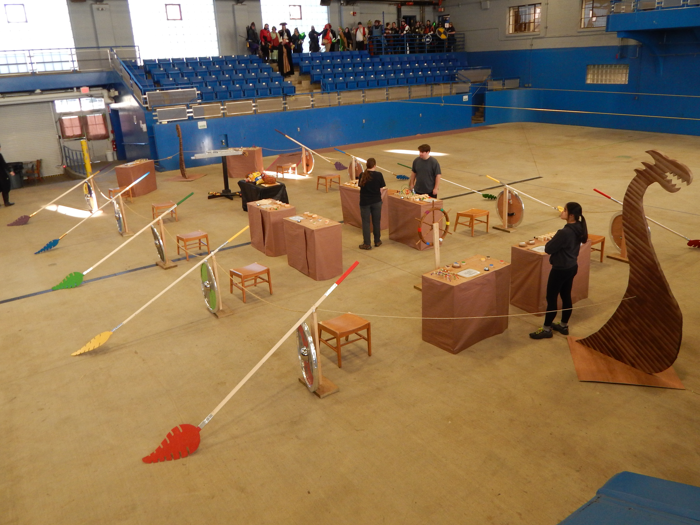 Following Llwellen, then, to the docks, the adventurers saw the vessel sitting in port. Pristine, bustling with controls and armaments, a sleek and purposeful craft that would undoubtedly serve the heroes well in their mission to traverse the skies and reach Mane. Llwellen then helped the heroes learn how the ship was operated. Dials and levers and knobs and switches controlled the flight maneuvers they would need to attempt. A captain’s wheel and ten feathered oars would allow them to increase their speed and traverse their course. Ten stalwart shields would protect the ship from any dangers on the way. A mighty ballista boasted the power to obliterate threats in their path. Most of all, in bonding with a captain, the airship gained a voice of its own so that it could speak its needs to its crew and provide valuable advice and aid in their travels.
Following Llwellen, then, to the docks, the adventurers saw the vessel sitting in port. Pristine, bustling with controls and armaments, a sleek and purposeful craft that would undoubtedly serve the heroes well in their mission to traverse the skies and reach Mane. Llwellen then helped the heroes learn how the ship was operated. Dials and levers and knobs and switches controlled the flight maneuvers they would need to attempt. A captain’s wheel and ten feathered oars would allow them to increase their speed and traverse their course. Ten stalwart shields would protect the ship from any dangers on the way. A mighty ballista boasted the power to obliterate threats in their path. Most of all, in bonding with a captain, the airship gained a voice of its own so that it could speak its needs to its crew and provide valuable advice and aid in their travels.
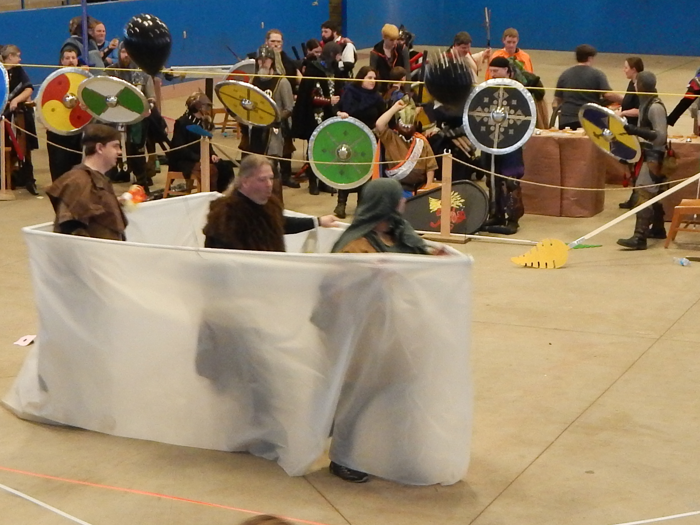 To the skies the heroes of the Realms ascended. It was by no means an easy journey. When setting into the next port to gather supplies for their journey, the heroes discovered that it was being raided by air pirates in small flying craft of their own. Throwing firebombs at the adventurers’ vessel, these ships proved a terrifying foe. Fortunately at the airdock itself were the scattered supplies necessary for the heroes to construct their own bombs. As they fired back at the enemy craft they were able to, one by one, rend the balloons that kept them aloft. When the last of each of those balloons was destroyed, the pirates crafts sunk below past the clouds and to an uncertain fate.
To the skies the heroes of the Realms ascended. It was by no means an easy journey. When setting into the next port to gather supplies for their journey, the heroes discovered that it was being raided by air pirates in small flying craft of their own. Throwing firebombs at the adventurers’ vessel, these ships proved a terrifying foe. Fortunately at the airdock itself were the scattered supplies necessary for the heroes to construct their own bombs. As they fired back at the enemy craft they were able to, one by one, rend the balloons that kept them aloft. When the last of each of those balloons was destroyed, the pirates crafts sunk below past the clouds and to an uncertain fate.
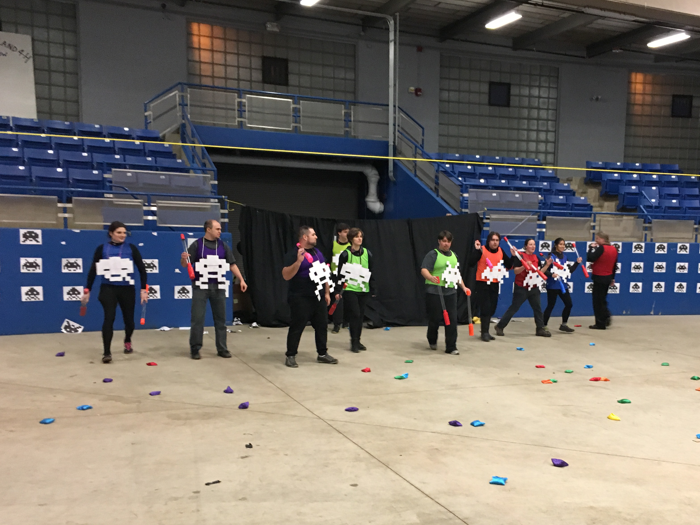 Further threats would follow as the heroes sailed through the clouds. Giant, vicious birds and dragons of both fire and ice assailed the vessel as it continued to ascend. The adventures contended with giant vines that latched onto the ship as they flew by a floating island. They had to free their compatriots from the gelatinous clutches of a space amoeba by firing magical armaments and flying after them with jet packs. They had to fend off an attack of aliens firing bolts of lights at their ship. And all the while they expertly executed flight maneuvers and accelerated rowing speeds by using the tools available to them. Finally, having succeeded at one more complicated landing maneuver, the airship touched down on the surface of Mane.
Further threats would follow as the heroes sailed through the clouds. Giant, vicious birds and dragons of both fire and ice assailed the vessel as it continued to ascend. The adventures contended with giant vines that latched onto the ship as they flew by a floating island. They had to free their compatriots from the gelatinous clutches of a space amoeba by firing magical armaments and flying after them with jet packs. They had to fend off an attack of aliens firing bolts of lights at their ship. And all the while they expertly executed flight maneuvers and accelerated rowing speeds by using the tools available to them. Finally, having succeeded at one more complicated landing maneuver, the airship touched down on the surface of Mane.
Upon disembarking, the adventurers immediately met a wizened old elf who had seen their approach and thus prepared for them a hot meal, knowing that their journey must had been a long and harrowing one. Taking the heroes to his mountain hideout, the venerable old elf explained that for centuries the moon had served at a penal colony for dark elves, prisoners of war for the ceaseless conflict between the elves and their evil cousins. When the Black Death attacked, however, and most of the population of Mane was destroyed, the dark elves escaped their confinement and now ran amok. The old elf did know of the ancient machinery that once propelled the moon through the sky, he had once seen it all as a child, and he promised to guide the heroes to each of the devices if they were strong enough to beat back the dark elves that were sure to be in their path.
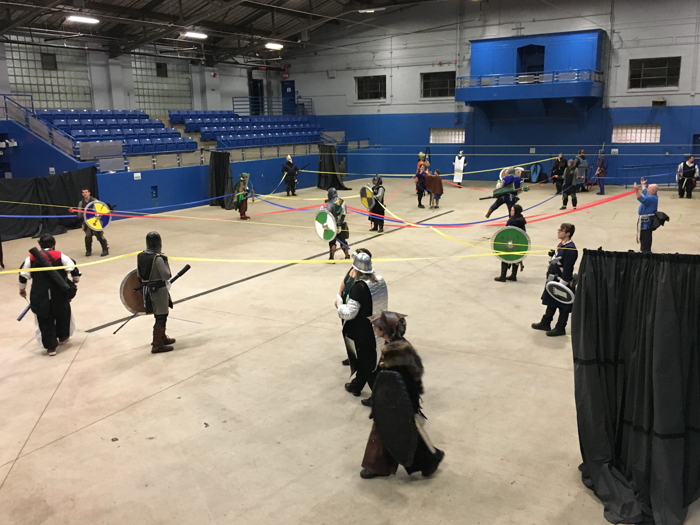 Following the lead of the elf, the heroes battled their way to several destinations. There was a fortification where they needed to break their way through by setting energy cubes to the correct side. At the end, a giant machine that needed to be wound through the strength of many adventurers working together. Next, there was a room where magical conduits needed to be attached to heroes standing at colored nodes all while redirecting the pathways of automations who would accidentally destroy them if they passed through. They next needed to add energy to the atmosphere by gathering latent energy from slain dark elves. They used this energy, in the form of little stones, to create storm-callers which they shook to summon a tempest that would provide energy to the ancient lunar machines.
Following the lead of the elf, the heroes battled their way to several destinations. There was a fortification where they needed to break their way through by setting energy cubes to the correct side. At the end, a giant machine that needed to be wound through the strength of many adventurers working together. Next, there was a room where magical conduits needed to be attached to heroes standing at colored nodes all while redirecting the pathways of automations who would accidentally destroy them if they passed through. They next needed to add energy to the atmosphere by gathering latent energy from slain dark elves. They used this energy, in the form of little stones, to create storm-callers which they shook to summon a tempest that would provide energy to the ancient lunar machines.
 Finally, the heroes approached a huge chasm on the moon that blocked their way forward. While they could chisel out blocks of stone and use them to construct a bridge across, their job was made much more difficult as the dark elves had equipped themselves with jet packs and were riding upon dragons. The adventurers carried stone and made their way across slowly as they fought back their foes and eventually managed to reach the other side, slaying all their enemies in the process. There, on the other side of the hastily constructed bridge, was the final machine.
Finally, the heroes approached a huge chasm on the moon that blocked their way forward. While they could chisel out blocks of stone and use them to construct a bridge across, their job was made much more difficult as the dark elves had equipped themselves with jet packs and were riding upon dragons. The adventurers carried stone and made their way across slowly as they fought back their foes and eventually managed to reach the other side, slaying all their enemies in the process. There, on the other side of the hastily constructed bridge, was the final machine.
The heroes of the Realms activated that final machine through pulling an extremely long cord for enough time as to start the ancient engines that gave Mane its power to move. The ground quaked and very slowly all present witnessed the reawakening of the moon and the revival of its pathway through the heavens. Nearby a circle of stones stood waiting for the heroes, an ancient elven transport gate that would allow them to instantly go home. Equipped with the plans to make connecting transport gates to get back there, Ulric agreed to build such a structure in Jomsviking lands, thus giving the heroes of the Realms the power to return to Mane whenever they please and thus forge a way forward to Asgard.
❧ Echoes of Ragnarok V: Asgard, October 26, 1019
In the preceding months the heroes of the realms had received two summons from Ulric of the Jomsvikings. The first, the predictable description of the mission and goals that they would undertake when they next traveled to Norlund. The second, a hurried warning that virtually all of Midgard had collapsed into a warzone and that long before the erosion from Ragnarok could be stopped the Jomsvikings and all their allies across the worlds might be wiped out from their enemies’ aggression. The heroes knew that in order to get to the portal that would take them to Asgard, they would certainly be crossing swords with the armies of Jarl Thorafin.
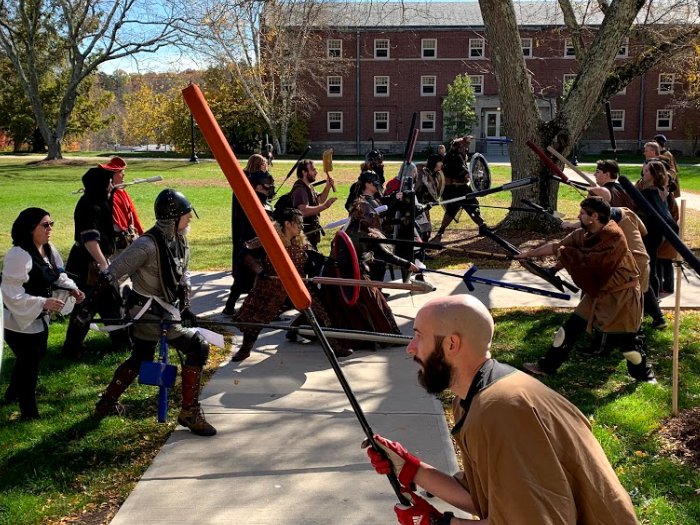 And cross swords they did. Immediately upon traveling through the Vanfrost the adventures stepped into battle with the enemy vikings. All of the Jomsviking’s camp had been overrun and, to make it to the portal, the heroes had to push their way through wave after wave of the jarl’s warriors that were there to prevent exactly that. Slowly they progressed through the melee and before long found the huge stone arch that would bring them to Asgard. One by one the heroes of the Realms stepped through.
And cross swords they did. Immediately upon traveling through the Vanfrost the adventures stepped into battle with the enemy vikings. All of the Jomsviking’s camp had been overrun and, to make it to the portal, the heroes had to push their way through wave after wave of the jarl’s warriors that were there to prevent exactly that. Slowly they progressed through the melee and before long found the huge stone arch that would bring them to Asgard. One by one the heroes of the Realms stepped through.
On the other side of the portal, in Asgard, the heroes found themselves before a great set of stairs that led to a humongous, but deserted hall. As they attempted to take stock of their surroundings and as well look for any sign of the gods they had hoped to confront, a booming, but obviously pained sound echoed throughout the room. The disembodied voice was that of Thor. He had forseen the arrival of the heroes, knowing that they would arrive mere moments before he, the last of the living Asir, faded away forever. In the final minutes of his existence he pleaded with the heroes for aid.
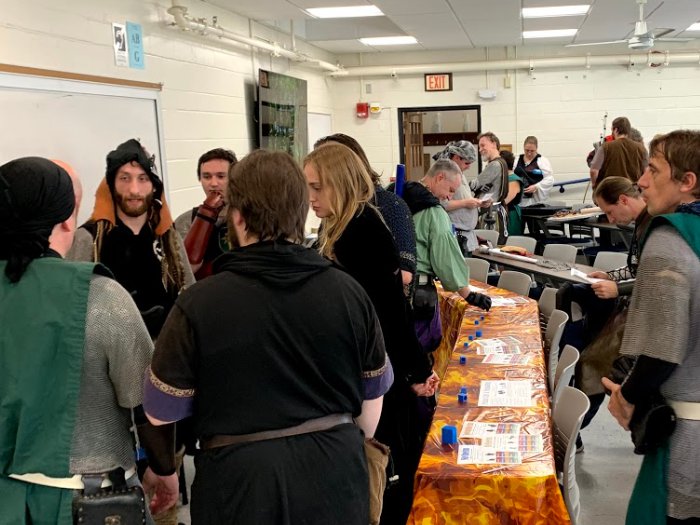 Divinity had all but abandoned Norlund. In the breaking that was done with the invasion of the Black Death the conduits through which divine energy circulated through the multiverse were severed from Asgard. Without that energy to subsist on the gods and all the rest of Norlund was fated to fade away. The heroes could reverse this situation, however, by traveling through the multiverse and reopening the pathways to allow that energy to flow back into Norlund once again. In order to do so, they would have to first erect symbols of worship in each reality they traveled to and second discover and recreate secret hidden runes called the Asirrunes, setting them in the Ether between worlds to redirect these energies toward Asgard.
Divinity had all but abandoned Norlund. In the breaking that was done with the invasion of the Black Death the conduits through which divine energy circulated through the multiverse were severed from Asgard. Without that energy to subsist on the gods and all the rest of Norlund was fated to fade away. The heroes could reverse this situation, however, by traveling through the multiverse and reopening the pathways to allow that energy to flow back into Norlund once again. In order to do so, they would have to first erect symbols of worship in each reality they traveled to and second discover and recreate secret hidden runes called the Asirrunes, setting them in the Ether between worlds to redirect these energies toward Asgard.
This was but one of the things required of them, however. For while these tasks would allow divine energy to again bring life to Norlund, the Asir and Vanir had already faded out of existence. In their place the heroes would be responsible for marshaling the redirected energy to birth new gods. In order to do so they were each individually tasked with using divine clay to craft “aspect tiles”, works of art that would determine what domains the new Asir would have command over.
Still one important task remained for the heroes besides these. Just as the Jomsvikings were being overrun by their enemies, so were the allies of the heroes in each of the six lower worlds. Beset by enemies that wanted to ultimately stop Norlund from being repaired. The heroes could not set foot on those worlds to aid the battles but in the halls of the Asir they found the tools that would allow them to create soldiers out of divine clay and portal them to those worlds to aid in the in the conflict. They could wrest control of each world from the enemy forces if they could manage to hold most of the defensive structures across the landscape.
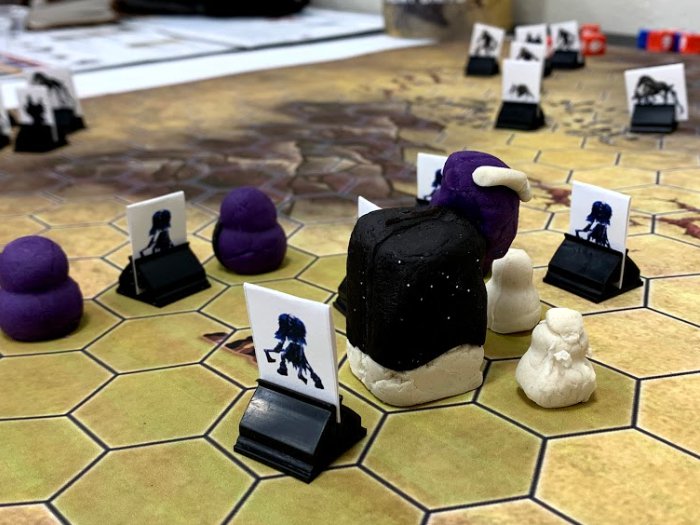 Having emparted this wisdom and these directions to the adventurers from the Realms, Thor at last could no longer hang on to the final bits of will and ego that were left to him, and the lord of storms finally faded out of existence, leaving Norlund finally devoid of all gods. The heroes had many duties placed before them. To reinvigorate Asgard with divine energy, to author the aspects of the new gods, to add to and direct the battles that were taking place even as they sought to understand how to best effect them. And so there was little left for them to do but enter the Ether and travel the multiverse to begin their journey.
Having emparted this wisdom and these directions to the adventurers from the Realms, Thor at last could no longer hang on to the final bits of will and ego that were left to him, and the lord of storms finally faded out of existence, leaving Norlund finally devoid of all gods. The heroes had many duties placed before them. To reinvigorate Asgard with divine energy, to author the aspects of the new gods, to add to and direct the battles that were taking place even as they sought to understand how to best effect them. And so there was little left for them to do but enter the Ether and travel the multiverse to begin their journey.
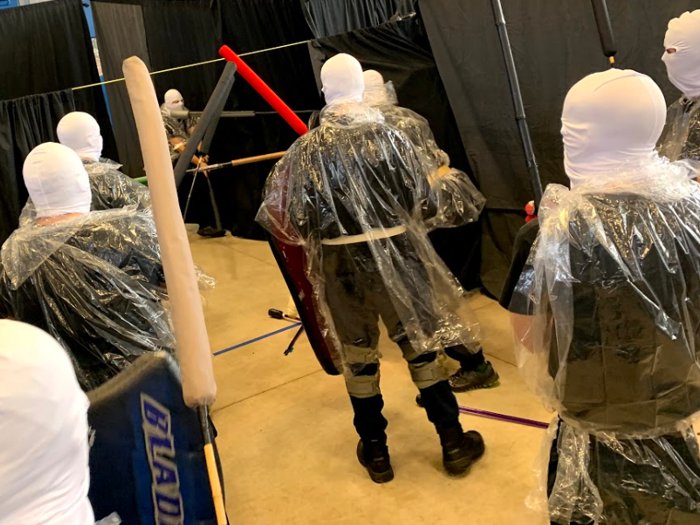 As the heroes stepped through the portal into the Ether they found a maze of spectral walls and opposing their every step were odd misformed monsters that were immediately hostile. These were clay elementals, made of the very substance that gods across all realities tap into to create life. As the heroes mowed down these foes they collected from them the divine clay they needed to use for the tasks that awaited them in Asgard. While pressing through the Ether, the heroes also found energy gems, precious crystals, and other objects composed of divine energy that would allow them to effect the wars happening on the lower worlds. They also found clues on how to compose each of the Asirrunes through understanding the mathematics within.
As the heroes stepped through the portal into the Ether they found a maze of spectral walls and opposing their every step were odd misformed monsters that were immediately hostile. These were clay elementals, made of the very substance that gods across all realities tap into to create life. As the heroes mowed down these foes they collected from them the divine clay they needed to use for the tasks that awaited them in Asgard. While pressing through the Ether, the heroes also found energy gems, precious crystals, and other objects composed of divine energy that would allow them to effect the wars happening on the lower worlds. They also found clues on how to compose each of the Asirrunes through understanding the mathematics within.
 Having emerged from the Ether passageways, the adventurers found themselves in the first universe of their quest. A vast jungle stood before them, dense with vines and anicient trees, swarming with venomous snakes. The heroes had to cut their way through the vegetation to make any progress forward but also remain wary of the bites of the serpents which had a toxin more powerful that their usual magics could resist. They did, however, find the directions to create antivenoms that would protect them from snake bites and having harvested the components from the jungle and made that alchemical panacea, the heroes were a bit more equipped to survive that hostile environment. Near the center of the jungle the heroes found building plans for a temple, perhaps placed there through some divine will. By busting apart rotted stumps they were able to harvest enough wood to follow those blueprints and eventually erected the temple as directed. Having completed that structure, the pathway through the Ether reopened and the players set in place the first of the asirrunes they had composed.
Having emerged from the Ether passageways, the adventurers found themselves in the first universe of their quest. A vast jungle stood before them, dense with vines and anicient trees, swarming with venomous snakes. The heroes had to cut their way through the vegetation to make any progress forward but also remain wary of the bites of the serpents which had a toxin more powerful that their usual magics could resist. They did, however, find the directions to create antivenoms that would protect them from snake bites and having harvested the components from the jungle and made that alchemical panacea, the heroes were a bit more equipped to survive that hostile environment. Near the center of the jungle the heroes found building plans for a temple, perhaps placed there through some divine will. By busting apart rotted stumps they were able to harvest enough wood to follow those blueprints and eventually erected the temple as directed. Having completed that structure, the pathway through the Ether reopened and the players set in place the first of the asirrunes they had composed.
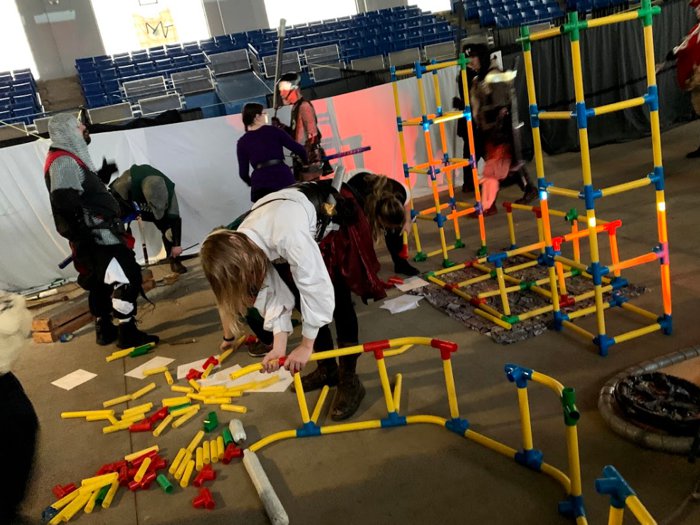 All throughout the day the heroes completed similar tasks. Their travels took them to a desert world with a rapidly flowing river where they had to transport materials upstream to build an obelisk. They traveled to an arctic world where they had to race against approaching glaciers, keeping them at bay with fires, while they hastily constructed a henge arch under the aurora borealis. They found themselves in a meterteranian world where they had to build boats and sail the coastline in order to build a set of columns along the shore. In each jump between realities they fought clay elementals and gathered clues to create Asirrunes. After completing their tasks in each successive universe they returned to Asgard to craft aspect tiles, recreate the runes, and direct the battles happening in the worlds below.
All throughout the day the heroes completed similar tasks. Their travels took them to a desert world with a rapidly flowing river where they had to transport materials upstream to build an obelisk. They traveled to an arctic world where they had to race against approaching glaciers, keeping them at bay with fires, while they hastily constructed a henge arch under the aurora borealis. They found themselves in a meterteranian world where they had to build boats and sail the coastline in order to build a set of columns along the shore. In each jump between realities they fought clay elementals and gathered clues to create Asirrunes. After completing their tasks in each successive universe they returned to Asgard to craft aspect tiles, recreate the runes, and direct the battles happening in the worlds below.
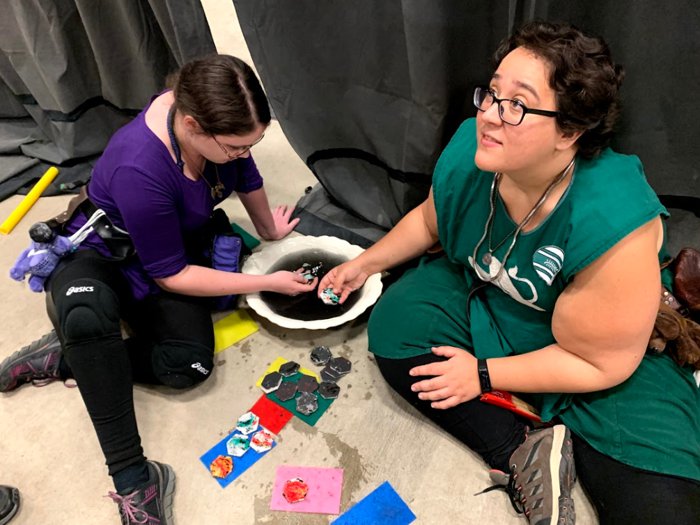 One ethereal jump in particular stood apart from the others. Upon emerging from the portal the heroes found themselves in front of a ruined temple. The banners hanging upon the broken stone drew sudden attention as they were immediately recognizable as those of Ashenmark. The adventurers had traveled through the Ether to an abandoned temple in the Realms and were surrounded by demons who had overrun the structure. The scene they beheld was the result of a once-failed quest other heroes had attempted several years before. At that time, adventurers from the Realms sought to resurrect from death Gaia’s son, Dio. That quest failed, however, when a demon succeded at stealing the power they had gathered to attempt this feat. Now, years later, other lesser demons were still feeding off of that same power but the potential to bring Dio back to life still existed. By slaughtering the demons to regain that divine energy and cleansing it in a fount that still remained untouched, the heroes were able to, with Gaia’s aid, succeed in the ritual to bring her son back to life. The heroes gave this reborn god the name Vivant who then awakened and promised his savors his aid in their ultimate quest to restore Norlund to right.
One ethereal jump in particular stood apart from the others. Upon emerging from the portal the heroes found themselves in front of a ruined temple. The banners hanging upon the broken stone drew sudden attention as they were immediately recognizable as those of Ashenmark. The adventurers had traveled through the Ether to an abandoned temple in the Realms and were surrounded by demons who had overrun the structure. The scene they beheld was the result of a once-failed quest other heroes had attempted several years before. At that time, adventurers from the Realms sought to resurrect from death Gaia’s son, Dio. That quest failed, however, when a demon succeded at stealing the power they had gathered to attempt this feat. Now, years later, other lesser demons were still feeding off of that same power but the potential to bring Dio back to life still existed. By slaughtering the demons to regain that divine energy and cleansing it in a fount that still remained untouched, the heroes were able to, with Gaia’s aid, succeed in the ritual to bring her son back to life. The heroes gave this reborn god the name Vivant who then awakened and promised his savors his aid in their ultimate quest to restore Norlund to right.
As the day waned, the adventurers’ tasks set out by Thor had all been completed. The Asirrunes were remade and hung in the Ether. Structures of worship in each universe visited were channeling energy back to Asgard. Tiles containing aspects of divinity were all constructed. The war on each of the lower worlds had been won thanks to the intervention by the heroes. It was time at last to finish the reason for their journey and as the visitors from the Realms were wondering exactly how they should proceed, the voice of Urd, one of the Norns and the reader of fate, echoed throughout the hall to tell the heroes what she foresaw and what remained of their quest.
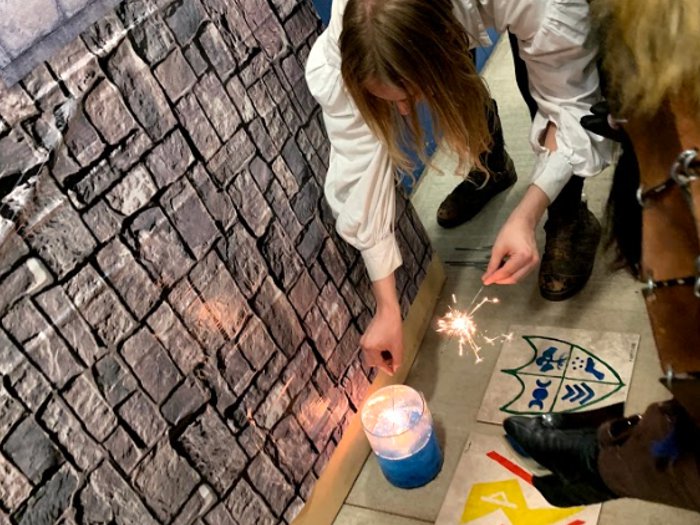 The heroes traveled to the grand temple that was in the highest mountains of Asgard. Standing in that temple were six huge stone cairns that would be the birthplace of the new Asir the adventurers sought to create, floating candles in a fount of water sitting in front of each. Thanks to Urd’s lyrical directions, the heroes knew what needed to be done so those new gods could come into existence. First they defeated clay elementals more monstrous than the ones they had faced thus far and from them were able to collect spheres of energy that burst from their body when they exploded. These energy spheres needed to be placed on each tile and the tiles arranged in front of each standing stone to determine which gods would control which domains. From the ether, holy fire needed to be transported from each Asirrune to light each candle. From the battles over each world that the heroes waged, those world’s essence needed to be added to the fount to color the water. Finally, as the ultimate, the heroes had to give their last breaths to the new Asir to will them into existence. Earth from the clay’s energy orbs, fire from the energy from the Asirrunes, water colored by the essence of each world, the last element was the breath of life from each hero. They died together and all laid sprawled out on the temple floor.
The heroes traveled to the grand temple that was in the highest mountains of Asgard. Standing in that temple were six huge stone cairns that would be the birthplace of the new Asir the adventurers sought to create, floating candles in a fount of water sitting in front of each. Thanks to Urd’s lyrical directions, the heroes knew what needed to be done so those new gods could come into existence. First they defeated clay elementals more monstrous than the ones they had faced thus far and from them were able to collect spheres of energy that burst from their body when they exploded. These energy spheres needed to be placed on each tile and the tiles arranged in front of each standing stone to determine which gods would control which domains. From the ether, holy fire needed to be transported from each Asirrune to light each candle. From the battles over each world that the heroes waged, those world’s essence needed to be added to the fount to color the water. Finally, as the ultimate, the heroes had to give their last breaths to the new Asir to will them into existence. Earth from the clay’s energy orbs, fire from the energy from the Asirrunes, water colored by the essence of each world, the last element was the breath of life from each hero. They died together and all laid sprawled out on the temple floor.
A long and silent moment hung in the air. Then a great voice spoke into the chaimer, echoing inside the spirits of the heroes even though they were deceased. It was the voice of Crow, named by his benefactors, he was the leader of the new pantheon that the heroes had thoughtfully crafted. He told the adventurers that they had succeeded. That he and his siblings had been born through their efforts and were stirring to awakedness even now. He told the heroes that the erosion of Norlund had now ceased, yet one task still remained for all of them to accomplish to finally and completely heal all of the worlds. A feat that must be undertaken one year from now, when the new Asir had fully grown into their power. With this, he willed all of the heroes back to life, and triumphantly they made their way home across the Vanfrost. A year from now they would heed the call to Norlund one last time.
❧ Echoes of Ragnarok V: Epilogue
The war between the Jomsvikings and the forces of Jarl Thorafin reached its dramatic apex, with Urlic’s forces finding themselves at last completely overmatched, the future looked grim. Yet, though he was not some great hero like those that had perished fighting the Black Death, Ulric was still a viking. He had still trained all his life to be a warrior, he still held the sanctity of his honor close to his heart. And with those warrior’s instincts and with that pledge of honor he had promised to keep clear the portal to Mane so that his allies from the Realms could arrive at Asgard. Now that the last of those heroes had stepped through the portal, Ulric had completed that duty, and he was resolved now to draw his last breath still in battle against those who would see all of creation destroyed for their own selfishness.
His remaining forces numbered but a few dozen. Battered from days of conflict, malnourished, ragged, little strength remained in the Jomsvikings to even make their last stand a glorious one. After all, they were not peerless warriors, they were small, humble men and women who had lived their lives without ever having done a great deed or having had a song sung in their honor. Yet, despite those things, each of them knew that they at least deserved to die on their feet, never having turned to flee. None of them would bear the shame of having a death-wound on their backs.
Certain now that he would perish in battle, blinded to everything but each next swing of his sword, it was almost impossible for Ulric to comprehend what happened next. All of a sudden, all throughout his ranks, the brightest of lights burst into existence and as each one faded in its place stood a man or woman fully armed and armored, complete understanding and purpose reflected in their glowing eyes. With nothing more than a cry of war these unexpected and inscrutable allies threw themselves into battle with a divine fury. Their strength was beyond comprehension, their actions thoughtful and coordinated and decisive. Jarl Thorafin’s warriors were immediately forced to give ground against their onslaught.
All across the six lower worlds this scene was repeated. In each of them were allies that the heroes of the Realms had made in their quest to set Norlund to right. In each of them were enemies united in purpose, to stop both the onset of Ragnarok or the worlds’ healing so that they might continue to rule in the anarchy of death that had gripped the lands. In each of those worlds war was joined and in each of those worlds, heroic allies born from bursts of light threw themselves into battle and started to push the enemy back.
The tide of of all of those battles swiftly and permanently changed.
In an empty but resplendently beautiful hall in the highest mountains of Asgard, holy energies began to stir for the first time in years. For months upon months the essence of divinity had drained from Norlund without pause, but that diminishing had now ceased. Instead energies poured into that room, originating from all throughout the multiverse, channeled through incomprehensible runes bathed in glowing light. Slowly but steadily, new Asir began to grasp their own egos and awaken to life.
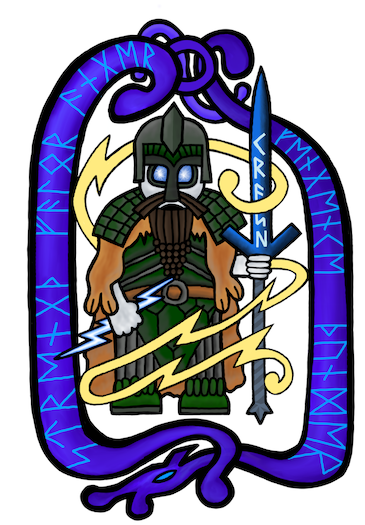 Out of one great stone cairn a towering, imposing man took a confident first step. His skin was alabaster and about his shoulders was a great fur cloak adorned with armored plates. In one hand he held a thunderbolt, brightest of blue in color, crackling with energy. In the other an impossibly tall greatsword, blade emblazoned with runes, it’s terrible sheen speaking to the deadly fury with which it could be wielded. His name was Crow, patron Asir of Nivelheim, and he ruled over the domains of Fortitude, Thunder, and Vengeance. He looked about the otherwise vacant hall and saw the other standing stones beginning to birth his kin, but he also saw unused aspect tiles that lay all around his feet. He raised his arm into the air and set his gaze upon two of them. A flight of drakes, a woman with a fish’s tail. And gathering the divine energies that swirled though the room, Crow willed into existence his daughter, Thyra, Patron of Dragons and Mermaids.
Out of one great stone cairn a towering, imposing man took a confident first step. His skin was alabaster and about his shoulders was a great fur cloak adorned with armored plates. In one hand he held a thunderbolt, brightest of blue in color, crackling with energy. In the other an impossibly tall greatsword, blade emblazoned with runes, it’s terrible sheen speaking to the deadly fury with which it could be wielded. His name was Crow, patron Asir of Nivelheim, and he ruled over the domains of Fortitude, Thunder, and Vengeance. He looked about the otherwise vacant hall and saw the other standing stones beginning to birth his kin, but he also saw unused aspect tiles that lay all around his feet. He raised his arm into the air and set his gaze upon two of them. A flight of drakes, a woman with a fish’s tail. And gathering the divine energies that swirled though the room, Crow willed into existence his daughter, Thyra, Patron of Dragons and Mermaids.
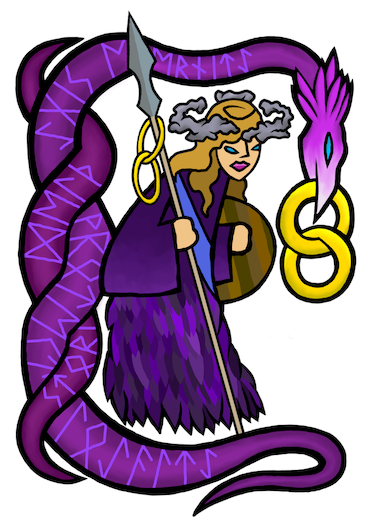 Stirred to full awakeness by the giant man and his use of the temple’s energies, the standing stone next to Crow pulsed with light and another figure stepped forth. A slender woman with fierce eyes, who about her head wore a crown of swirling clouds. She was draped in a long purple gown that at some angles seemed to be cloth and at others appeared to be made of thousands of small feathers. On one of her arms was clasped a shimmering shield that gave the immediate impression of invincibility. In her other she held a long spear and dangling from it’s haft under the spearhead were two large golden rings, permanently linked together. Her name was Lormar, Patron Asir of Helheim, and she ruled over the domains of Storms, Defense, and Loyalty. Like her brother who was born only moments before, Lormar also took stock of the unused aspects around the room and with her spear pointed to two of them. One set with runes and swirling purple lines, one a pair of masks showing joy and sorrow. She then stuck the handle of her spear onto the ground and through it channeled the powers in the hall to beget her son, Birger, God of Magic and Theatre.
Stirred to full awakeness by the giant man and his use of the temple’s energies, the standing stone next to Crow pulsed with light and another figure stepped forth. A slender woman with fierce eyes, who about her head wore a crown of swirling clouds. She was draped in a long purple gown that at some angles seemed to be cloth and at others appeared to be made of thousands of small feathers. On one of her arms was clasped a shimmering shield that gave the immediate impression of invincibility. In her other she held a long spear and dangling from it’s haft under the spearhead were two large golden rings, permanently linked together. Her name was Lormar, Patron Asir of Helheim, and she ruled over the domains of Storms, Defense, and Loyalty. Like her brother who was born only moments before, Lormar also took stock of the unused aspects around the room and with her spear pointed to two of them. One set with runes and swirling purple lines, one a pair of masks showing joy and sorrow. She then stuck the handle of her spear onto the ground and through it channeled the powers in the hall to beget her son, Birger, God of Magic and Theatre.
 Life surging into the room inspired yet more life to join it. On the other end of the hall another cairn surged with energy and out of it stepped a man much different in stature than Crow. He was slight in his form, lithe and quick in appearance. Out of his brow grew two great golden antlers. In one hand he held a threshing flail, in the other a lantern emitting a warm glow. From his shoulders grew out several thin branches that knit together and fell down his back and they created a cape made of leaves and vines. What is more, his existence was altogether something incomprehensible. He was certainly an Asir of this world, as much so as his brother and sister that came before him, but his divinity existed elsewhere as well. And in that other place, his mother Gaia rejoiced looking over the temple in a place called Ashenmark that would be the seat of his power. There he was the just-restored god of Rebirth, but here in Norlund he held different aspects. His name was Vivant, patron of Jotunheim and his domains were those of hope, hearth, community, and the stag.
Life surging into the room inspired yet more life to join it. On the other end of the hall another cairn surged with energy and out of it stepped a man much different in stature than Crow. He was slight in his form, lithe and quick in appearance. Out of his brow grew two great golden antlers. In one hand he held a threshing flail, in the other a lantern emitting a warm glow. From his shoulders grew out several thin branches that knit together and fell down his back and they created a cape made of leaves and vines. What is more, his existence was altogether something incomprehensible. He was certainly an Asir of this world, as much so as his brother and sister that came before him, but his divinity existed elsewhere as well. And in that other place, his mother Gaia rejoiced looking over the temple in a place called Ashenmark that would be the seat of his power. There he was the just-restored god of Rebirth, but here in Norlund he held different aspects. His name was Vivant, patron of Jotunheim and his domains were those of hope, hearth, community, and the stag.
Meanwhile, in Nivelheim, an eerie, cautious calm had settled over the final battlefield of the war.
The otherworldly reinforcements had changed everything. As they had rushed forward almost ceaselessly from portals in each of the worlds, the heroic denizens of each plain happily got caught up in the fury of their battle and joined them in their fervor. The enemies that had all but conquered existence found themselves outnumbered and overmatched by not just men and women but giants and dragons and monsters unimaginable that had all joined the same holy cause. One by one the enemy’s strongholds fell. The heroes of Midgard, Jotunheim, and Helheim were the first to obliterate the foes that had at one point brought them to heel. Shortly afterwards, the heroes of Muspelheim and Svartalheim had taken hold of every defensible structure in their realms. Yet in Nivelheim things took a turn for the worse. Realizing it was the one battlefield where they had a chance at victory, the enemy used dark and secret ancient magics to rally all their scattered forces to that one world creating a force that could easily overpower the heroes. For a time, it seemed likely that Nivelheim would be lost to the enemy and become the seat of their power while they rebuilt and again readied for war. But that was not to be. Yet another miracle occurred as portals opened up in each of the other lower worlds allowing all the heroic warriors to step through and join together in one great allied army of all the realms.
The battle that was joined then was an epic one. Fire salamanders bit through the freezing hides of ice jotun, bone dragons crushed dark elves beneath their feet, vikings and dwarves, side by side, assailed wyrms and hounds and other monstrosities that would otherwise be far beyond their power. For hours the fight continued and the ebb and flow of the war shifted many times. At last with one final offensive push by the heroes the enemy army finally broke ranks and fled, leaving the combined army of the six worlds victoriously, ultimately, over their realms.
It was a long and hard-fought series of battles and their cost was incalculably high. But they were over. The heroic armies had won. And while new Asir were just being born in the realm above, Ulric looked over the remaining men and women of his Jomsvikings. Warriors who had pledged everything, sacrificed everything to win this day and help create a new future for themselves and for their children. No, they were not great heroes. No, stories might never be sung about the blood they spilled or the walls they scaled, but there was still an important duty left to all of them now. He communicated that duty with little more than a nod to all around him. At once a thank you and a goodbye to everyone who bled together to build a way forward for their world. And so, the denizens of the six lower planes left Nivelheim and returned to their homes to begin their final and most important duty. To rebuild.
 Back in the Grand Temple of Asgard, another standing stone pulsed with life. Flames erupted into the chamber as a figure, swirling with fire, took a step out of the solid rock. In one hand they held a gigantic tome unburned by the blaze it endured, in the other they held a staff adorned with gemstones, surrounded by swirling torrents of every color of the rainbow. They wore a flowing white robe with a hood covering all but the lower part of their face, but of particular note were their feet, upon which were a pair of sandals that were tattered and frayed as if they were not brand new but had endured many lifetimes of use. They were Sovereign, patron Asir of Muspelheim, and their domains were that of Saga, Reality, and Progression. When it was their turn to set their gaze upon the unused aspects they chose three. A figure making strides up a steep hill, a white untouched field, and a compass and campfire. And from these Sovereign created their three triplet children. Their son Odgar, god of Effort, their daughter, Liv, goddess of adaptability, and their son Knud, god of Travel.
Back in the Grand Temple of Asgard, another standing stone pulsed with life. Flames erupted into the chamber as a figure, swirling with fire, took a step out of the solid rock. In one hand they held a gigantic tome unburned by the blaze it endured, in the other they held a staff adorned with gemstones, surrounded by swirling torrents of every color of the rainbow. They wore a flowing white robe with a hood covering all but the lower part of their face, but of particular note were their feet, upon which were a pair of sandals that were tattered and frayed as if they were not brand new but had endured many lifetimes of use. They were Sovereign, patron Asir of Muspelheim, and their domains were that of Saga, Reality, and Progression. When it was their turn to set their gaze upon the unused aspects they chose three. A figure making strides up a steep hill, a white untouched field, and a compass and campfire. And from these Sovereign created their three triplet children. Their son Odgar, god of Effort, their daughter, Liv, goddess of adaptability, and their son Knud, god of Travel.
 The fifth standing stone then burst with energy and from it emerged a man smaller in stature than his siblings but still giant by any reckoning. He wore long brown beard braided in three parts and his brow was furrowed in concentration. He was armored from head to toe in black shining platemaile, holding a great scale in one of his hands and a cudgel in the other. On each of his wrists was a shackle with a broken chain. His name was was Graynar, patron Asir of Svartalvheim, ruler of the domains of Law, Freedom, and the Balance between the two. He spotted an aspect tile adorned with a castle and a crown and from it willed into existence his son Bergernarit, the god of Leadership. Then he noticed a lone remaining tile depicting the image of a comet streaking through the starlit heavens and from it begat his daughter Apoc, goddess of the Night Sky.
The fifth standing stone then burst with energy and from it emerged a man smaller in stature than his siblings but still giant by any reckoning. He wore long brown beard braided in three parts and his brow was furrowed in concentration. He was armored from head to toe in black shining platemaile, holding a great scale in one of his hands and a cudgel in the other. On each of his wrists was a shackle with a broken chain. His name was was Graynar, patron Asir of Svartalvheim, ruler of the domains of Law, Freedom, and the Balance between the two. He spotted an aspect tile adorned with a castle and a crown and from it willed into existence his son Bergernarit, the god of Leadership. Then he noticed a lone remaining tile depicting the image of a comet streaking through the starlit heavens and from it begat his daughter Apoc, goddess of the Night Sky.
As the new Asir and their children looked about the chamber and spoke to one another for the first time they began to conference about the fate of Norlund and how they could best fulfill their roles in making their universe again team with life and prosperity. Though each of them had existed for but a brief few moments in time, they intrinsically understood the state of their worlds and the domains over which they were to preside. In those first few moments of their being, everything about who they were and how they would bring peace to their realms began to settle.
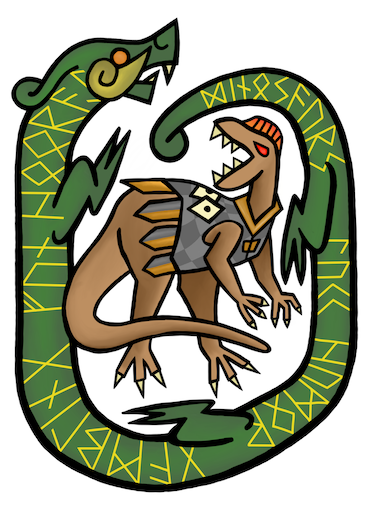 Then the sixth, unnoticed, standing stone rumbled to life almost lifting itself off the ground in its ferocity. From the face of the stone stepped a single scaled claw, razor talons jutting from each digit. Then another. Then suddenly bursting into the hall was the final member of the new Asir. The being could only be described as a dilophosaurus, standing on two muscular hind legs, a pair of bright orange frills across the top of her head. Draped across her broad back and small shoulders was a surcoat of fine gold and silver threads, beautifully made as if by a great artisan, with a giant pair of dice embroidered on the back, showing a single pip on each. As the thunder-lizard regarded her brothers and sisters she opened her great toothy mouth and let loose an echoing high-pitched roar. This was Tychasaurus, patron Asir of Midgard, ruler over the domains of luck and fun, lord of all dinosaurs.
Then the sixth, unnoticed, standing stone rumbled to life almost lifting itself off the ground in its ferocity. From the face of the stone stepped a single scaled claw, razor talons jutting from each digit. Then another. Then suddenly bursting into the hall was the final member of the new Asir. The being could only be described as a dilophosaurus, standing on two muscular hind legs, a pair of bright orange frills across the top of her head. Draped across her broad back and small shoulders was a surcoat of fine gold and silver threads, beautifully made as if by a great artisan, with a giant pair of dice embroidered on the back, showing a single pip on each. As the thunder-lizard regarded her brothers and sisters she opened her great toothy mouth and let loose an echoing high-pitched roar. This was Tychasaurus, patron Asir of Midgard, ruler over the domains of luck and fun, lord of all dinosaurs.
Certainly this development was an unexpected one, even by a new generation of Asir who already understood everything about their place in the universe. The rest of her divine family regarded Tychasaurus with a wide range of emotions. Crow was all too happy to have a sister who seemed well suited to do battle with their enemies. Lormar immediately understood that her reptilian sibling would be a great hinderance to the civility of their discussions. Vivant shared a kinship with her in their love for a fierce and untamed wild. Graynor was displeased knowing that this member of his family would never hold respect for the law of men, and Sovereign, they just shook their head in disappointment. And as Tychasaurus continued to roar out her greetings and the rest of the divine family struggled to comprehend her role in this new pantheon, something elsewhere in the temple was amiss.
In a dark corner, three aspect tiles sat torn asunder surrounded by a pool of ruined ritual components. If one was to inspect everything more closely they would have learned that the destroyed tiles were those of Death, Secrets, and The Hunt. Whatever happened in that place did so in such a way that the new Asir could not perceive it. Whatever occurred there was certainly something that was unnatural. And wrong.
Yet, regardless of that blemish of darkness, a great new light was spreading throughout all of Norlund. The erosion of the world had stopped. The energies focused from other universes and refined within the Asirunes had brought stability back to the realms and soon they would inspire growth to begin anew. The new Asir would grow in power as the denizens of the lower worlds learned of their existence, and a year from now the heroes of the Realms would return to complete one final task that would forever ensure the world they left behind would prosper.
❧ Echoes of Ragnarok VI: The Quiet Year, October 23, 1021
When the worlds of Norlund needed aid it had always been Ulric of the Jomsvikings that reached out to the Realms letting them know what deeds awaited them. The summoning this time, however, was altogether different. It was as if Norlund itself was speaking to the heroes through their dreams, showing them the threads of fate and how they might be plucked. It was a strange and inscrutable experience, but there could be no doubt that the heroes of the Realms were needed once more in the world that they had saved from destruction.
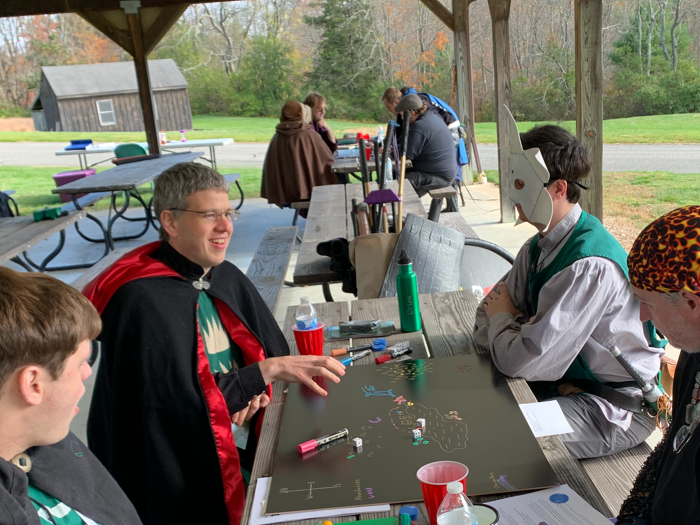 When the heroes made their way to Norlund this time it was not over the Vanfrost. You might say that they never physically traveled to Norlund at all. Through their dreams they were called to the place where fate, itself, was woven. Without truly understanding where they were or having full realization of their own egos, the heroes’ spirits were called to the domain of the Norns. There, a great spiritual loom stretched across the land, an implement that connected the lives and destinies of all people. Norlund was asking the heroes of the Realms to take ahold of this loom and through create futures for the people of Midgard. When the worlds of Norlund were remade they were blank slates, untamed and savage. The vikings that survived all the tribulations of their world formed small communities and set out to create communities throughout the land. It was the fates of those communities that the heroes were being asked to weave.
When the heroes made their way to Norlund this time it was not over the Vanfrost. You might say that they never physically traveled to Norlund at all. Through their dreams they were called to the place where fate, itself, was woven. Without truly understanding where they were or having full realization of their own egos, the heroes’ spirits were called to the domain of the Norns. There, a great spiritual loom stretched across the land, an implement that connected the lives and destinies of all people. Norlund was asking the heroes of the Realms to take ahold of this loom and through create futures for the people of Midgard. When the worlds of Norlund were remade they were blank slates, untamed and savage. The vikings that survived all the tribulations of their world formed small communities and set out to create communities throughout the land. It was the fates of those communities that the heroes were being asked to weave.
The heroes arranged themselves around four tables, at the center of each was a map. On each map, the living image of a viking settlement that had found a place to put down roots. The adventurers found that through their will they could manipulate the threads and manifest fate. They could create a future for the people living there, plucking and guiding the strings of causality to create epic stories that would become the history of these people and cement their legacies in the new age of Midgard.
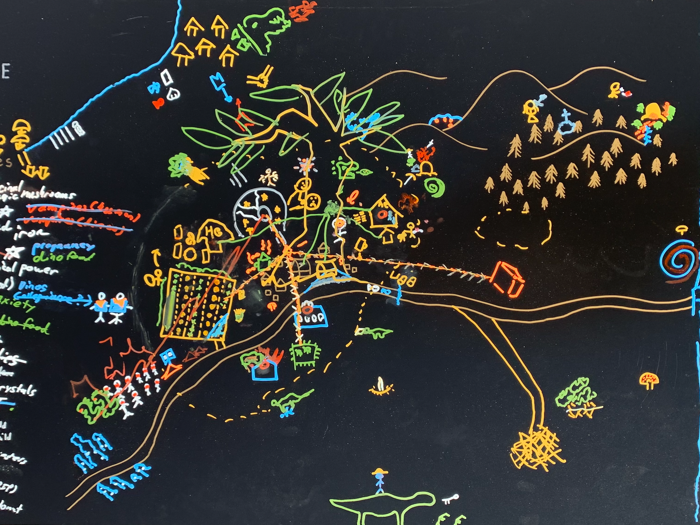 First there was the town of Eaglesville. This community had built itself around a natural rock formation called the Monument of Light which became the spiritual center of their lives. The settlement was fed by a pristine river and surrounded by gentle hill and dale. A true paradise in these untamed lands, but it was to become a paradise lost. A mysterious organization that named itself the Church of Tychesaurus declared war on the town and that was only the beginning of their woes. A plague of vampirism broke out across the land and even mighty dinosaurs succumbed to the thrall of the vampires. Yet a hero emerged in these dark times and with holy sword drove away the plague of undeath from the community. The people of Eagleville had won back their town and their lives but it was a short-lived victory. Soon afterwards an unspeakably giant tree limb broke apart the land and erupted through the center of town, crushing almost everything the people had built. They had lost much, but their will to live endured, and the people of Eaglesville set out together to rebuild their community on new land and with new hope for the future.
First there was the town of Eaglesville. This community had built itself around a natural rock formation called the Monument of Light which became the spiritual center of their lives. The settlement was fed by a pristine river and surrounded by gentle hill and dale. A true paradise in these untamed lands, but it was to become a paradise lost. A mysterious organization that named itself the Church of Tychesaurus declared war on the town and that was only the beginning of their woes. A plague of vampirism broke out across the land and even mighty dinosaurs succumbed to the thrall of the vampires. Yet a hero emerged in these dark times and with holy sword drove away the plague of undeath from the community. The people of Eagleville had won back their town and their lives but it was a short-lived victory. Soon afterwards an unspeakably giant tree limb broke apart the land and erupted through the center of town, crushing almost everything the people had built. They had lost much, but their will to live endured, and the people of Eaglesville set out together to rebuild their community on new land and with new hope for the future.
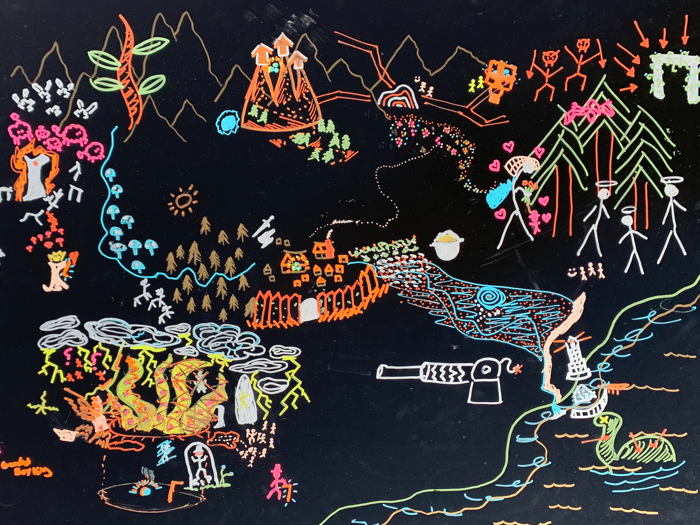 Then there was Pack Rock. Nestled between a tranquil coastline and a great mountain range, the people of Pack Rock soon learned that a great pit containing some unspeakable horror dwelled far too close to their homes. What is worse, though they set up barriers and prepared to wage war against whatever this creature was, it was able to deal the first blow as it inspired cultists to grow within the community. It seemed all would be lost to this eldritch tentacled monstrosity but for the statue to Fenrir that was discovered in the nearby woods. The townsfolk that had not been corrupted by the monster turned to the statue for their faith. This granted them lupine allies and the strength to bring battle to the beast in the pit, slaying it, along with the help of a giant cannon. As their worship of Fenrir deepened, members of the community gained through their devotion the gift of lycanthropy and the might to stave off other great threats. The attack of a Jotun tribe from the north, a mysterious old castle and the dangers within. All were defeated by might of arms and faith in Fenrir. When a giant tree branch thrust its way though the mountains, the panicked herds of dinosaurs that swept through might have destroyed other settlements. But those of Pack Rock were equal to the task and shed blood rather than tears to keep their town intact.
Then there was Pack Rock. Nestled between a tranquil coastline and a great mountain range, the people of Pack Rock soon learned that a great pit containing some unspeakable horror dwelled far too close to their homes. What is worse, though they set up barriers and prepared to wage war against whatever this creature was, it was able to deal the first blow as it inspired cultists to grow within the community. It seemed all would be lost to this eldritch tentacled monstrosity but for the statue to Fenrir that was discovered in the nearby woods. The townsfolk that had not been corrupted by the monster turned to the statue for their faith. This granted them lupine allies and the strength to bring battle to the beast in the pit, slaying it, along with the help of a giant cannon. As their worship of Fenrir deepened, members of the community gained through their devotion the gift of lycanthropy and the might to stave off other great threats. The attack of a Jotun tribe from the north, a mysterious old castle and the dangers within. All were defeated by might of arms and faith in Fenrir. When a giant tree branch thrust its way though the mountains, the panicked herds of dinosaurs that swept through might have destroyed other settlements. But those of Pack Rock were equal to the task and shed blood rather than tears to keep their town intact.
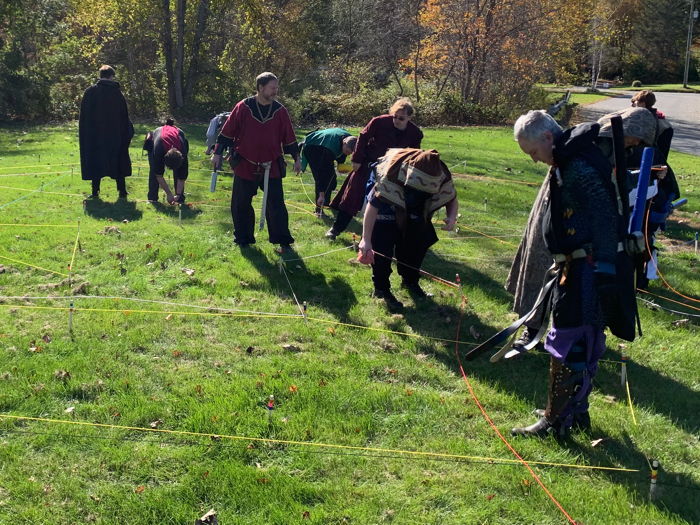 These kinds of stories were told, season by season, by the heroes of the Realms who sat around these maps and dictated through their thoughts how these people’s futures would unfold. They were not entirely themselves in these actions, yes, they had their own wills and their own desires, but they were also agents of fate, bound to the rules of the loom in which they sat. However, as each season passed, there were brief moments when the adventurers were shaken a bit from the thrall of the stories they wove and felt their egos return to them for a bit. In those moments they could understand the full force and form of the loom they were all within and took those opportunities to arrange the threads of causality to their own ends. Weaving the colored threads of fate through the loom as they wished, they unlocked new patterns of the future that could be made manifest, if they figured each of them out in full. In doing so, they had the opportunity to more directly effect what would happen in each future season of the year in those settlements.
These kinds of stories were told, season by season, by the heroes of the Realms who sat around these maps and dictated through their thoughts how these people’s futures would unfold. They were not entirely themselves in these actions, yes, they had their own wills and their own desires, but they were also agents of fate, bound to the rules of the loom in which they sat. However, as each season passed, there were brief moments when the adventurers were shaken a bit from the thrall of the stories they wove and felt their egos return to them for a bit. In those moments they could understand the full force and form of the loom they were all within and took those opportunities to arrange the threads of causality to their own ends. Weaving the colored threads of fate through the loom as they wished, they unlocked new patterns of the future that could be made manifest, if they figured each of them out in full. In doing so, they had the opportunity to more directly effect what would happen in each future season of the year in those settlements.
 Then there was the hamlet of Stonia. The community settled in a river junction and made use of the fertile surroundings to begin a life of working the land. But their lives were cast in the shadow of a gargantuan dinosaur, as large as the town itself, which wandered unabated around the landscape and would someday soon be close enough to the community to pose an unassailable threat. But if there was anything that could be said of the people of Stonia it was their industriousness, even in the face of danger. Defensive walls were created alongside infrastructure and improvements that made the town a veritable fortress paradise. In the end the monstrosity of a dinosaur was baited to turn around and forever wander away from the village, and the safety of their community was assured. Suddenly, south of the town, within the rows of crops in the fields, the land was shattered as a great tree branch thrust upward through the firmament. The surrounding fields for acres around were damaged and cut off from the sun. What would become of the community now?
Then there was the hamlet of Stonia. The community settled in a river junction and made use of the fertile surroundings to begin a life of working the land. But their lives were cast in the shadow of a gargantuan dinosaur, as large as the town itself, which wandered unabated around the landscape and would someday soon be close enough to the community to pose an unassailable threat. But if there was anything that could be said of the people of Stonia it was their industriousness, even in the face of danger. Defensive walls were created alongside infrastructure and improvements that made the town a veritable fortress paradise. In the end the monstrosity of a dinosaur was baited to turn around and forever wander away from the village, and the safety of their community was assured. Suddenly, south of the town, within the rows of crops in the fields, the land was shattered as a great tree branch thrust upward through the firmament. The surrounding fields for acres around were damaged and cut off from the sun. What would become of the community now?
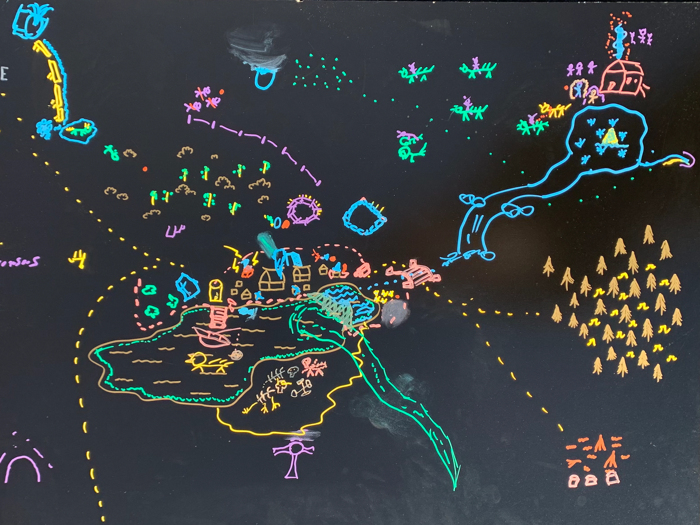 Lastly there was the village of Strifelake. Set along the shores of a great body of water, verdant fields all around them, endless potential to grow and build lives where they settled. Yet the challenges that this community faced were not small in number. It seemed one disaster after another befell these people not the least of which was the touch of forbidden magics. Rampaging kobolds across the countryside. Winds strong enough to fell trees. A mysterious mage killed in the streets. A child brought to undeath through evil means. The community began to buckle under these stressful events, almost splitting in twain as their beliefs and their fears divided them. Yet their faith in one another and what there were building together held fast. They cast the divisive elements out of their town and welcomed others that came earnestly with the wish to help. And just when it seemed like all of their woes were finally behind them, their Great Lake was torn asunder by a massive tree branch that shot upwards through the water, almost completely draining it if not for the influence and interference of those who wove their fates.
Lastly there was the village of Strifelake. Set along the shores of a great body of water, verdant fields all around them, endless potential to grow and build lives where they settled. Yet the challenges that this community faced were not small in number. It seemed one disaster after another befell these people not the least of which was the touch of forbidden magics. Rampaging kobolds across the countryside. Winds strong enough to fell trees. A mysterious mage killed in the streets. A child brought to undeath through evil means. The community began to buckle under these stressful events, almost splitting in twain as their beliefs and their fears divided them. Yet their faith in one another and what there were building together held fast. They cast the divisive elements out of their town and welcomed others that came earnestly with the wish to help. And just when it seemed like all of their woes were finally behind them, their Great Lake was torn asunder by a massive tree branch that shot upwards through the water, almost completely draining it if not for the influence and interference of those who wove their fates.
Four different communities, four different stories. All knitted together by the will of the heroes of the Realms, all culminating in the same great disastrous event. In those four villages and in countless other places all throughout Midgard, throughout all the worlds of Norlund, great roots and boughs and branches rendered the landscape asunder as they broke through in all manner of ways. Yes, Norlund had been saved but it was clear what the new Aesir spoke of when they once said that there was one task that remained before everything was whole once more. Before long, Norlund will call out to the heroes of the Realms once more and their might will, at last, set everything to right.
❧ Echoes of Ragnarok: The Conclusion: Yggdrasil, April 13, 1024
Years before, when the Heroes of the Realms created the new generation of Asir and Vanir, the chief of the new Asgardian pantheon, Crow, spoke to those assembled in the great palace. He explained that one final task remained before Norlund could be considered truly reborn and forever recovered from the devastation of The Black Death. When the heroes experienced The Quiet Year through their dreams and the domain of the Norns, they began to understand what that task might be. With the worlds of Norlund having been completely remade, the great world tree Yggdrasil no longer understood how to connect all the planes together and was thus growing out of control and tearing the worlds asunder. Ulric, meeting the heroes at the foot of the Vanfrost as always, explained that this final problem could be alleviated through two actions. First the heroes must locate a set of Holy Acorns and place them at the roots of Yggdrasil to allow it to create new growth. Second they must create a spirit for the world tree, a new Vanir that would allow Yggdrasil to have sapience and understand how it must grow.
 Shortly after Ulric rode off on his faithful Saurian Steed, Buttercup, the heroes of the Realms were visited by another who had a vested interest in their quest. When the new Asir were created in the great palace of Asgard, there were six stone cairns to allow to creation of six new gods. Yet there were some who were dissatisfied with this number and the aspects that were chosen for them. In a dark corner of the hall, some adventurers conspired to create their own hidden ritual and through it a malevolent additional Asir was birthed. Embodying the aspects of Death, Secrets, and The Hunt this seventh god strode towards the heroes and gave their name. The Huntsman.
Shortly after Ulric rode off on his faithful Saurian Steed, Buttercup, the heroes of the Realms were visited by another who had a vested interest in their quest. When the new Asir were created in the great palace of Asgard, there were six stone cairns to allow to creation of six new gods. Yet there were some who were dissatisfied with this number and the aspects that were chosen for them. In a dark corner of the hall, some adventurers conspired to create their own hidden ritual and through it a malevolent additional Asir was birthed. Embodying the aspects of Death, Secrets, and The Hunt this seventh god strode towards the heroes and gave their name. The Huntsman.
 The Huntsman explained that the death and destruction happening across Norlund from the berserk Yggdrasil was much to their liking. They had created an army of monstrous spiders and allied with the dark elves of Niflheim and together it was their aim to possess the world tree for themselves. In doing so they could continue the rampant and senseless death that occured when the limbs and roots grew out of control. Besides being a god of death, however, The Huntsman also embodied the spirit of The Hunt, an aspect that involved the age-old game between predator and prey. They agreed that if the army of heroes could achieve their aim before the rogue Asir could achieve theirs then they would admit defeat and seek another way to find admittance to the new Asgardian pantheon.
The Huntsman explained that the death and destruction happening across Norlund from the berserk Yggdrasil was much to their liking. They had created an army of monstrous spiders and allied with the dark elves of Niflheim and together it was their aim to possess the world tree for themselves. In doing so they could continue the rampant and senseless death that occured when the limbs and roots grew out of control. Besides being a god of death, however, The Huntsman also embodied the spirit of The Hunt, an aspect that involved the age-old game between predator and prey. They agreed that if the army of heroes could achieve their aim before the rogue Asir could achieve theirs then they would admit defeat and seek another way to find admittance to the new Asgardian pantheon.
 And so the Adventures, many atop their faithful Saurian Steeds that they had trained in the months before, set out across the lands of Midgard to find the Holy Acorns. They quickly found, however, that much of the countryside had been infested by giant, mysterious spiders who had woven a sprawling maze of webs across the land. Accompanying them in this labyrinth were dark elves, some of whom were mounted on their own Saurian Steeds. Strangely, those dark elves possessed the instructions and equipment to extract a fluid from the spiders they referred to as spider milk. The heroes of the Realms fought their way through this maze, seeking the Holy Acorn and along the way gathering spider milk, which they found would be an invaluable magic reagent, as well as a great deal of other magical tools and strange items. Not the least of which were giant bones that clearly belonged to a dinosaur of some kind. When at last they discovered the acorn they escaped the web and made their way back to their base camp.
And so the Adventures, many atop their faithful Saurian Steeds that they had trained in the months before, set out across the lands of Midgard to find the Holy Acorns. They quickly found, however, that much of the countryside had been infested by giant, mysterious spiders who had woven a sprawling maze of webs across the land. Accompanying them in this labyrinth were dark elves, some of whom were mounted on their own Saurian Steeds. Strangely, those dark elves possessed the instructions and equipment to extract a fluid from the spiders they referred to as spider milk. The heroes of the Realms fought their way through this maze, seeking the Holy Acorn and along the way gathering spider milk, which they found would be an invaluable magic reagent, as well as a great deal of other magical tools and strange items. Not the least of which were giant bones that clearly belonged to a dinosaur of some kind. When at last they discovered the acorn they escaped the web and made their way back to their base camp.
 Now that the heroes possessed the Holy Acorn it was necessary to place it at the roots of Yggdrasil so that it could lead to new growth. The root system of the world tree, however, was not so hospitable a place. Hanging over an endless void, the roots could only be traversed through the leaping ability of a Saurian Steed. Some mounted heroes, therefore, took to the platforms of roots to reach the stem on which to place their charge. The root system, unfortunately, was also infested with The Huntsman’s army. In order to remove the monstrous spiders from the path of the heroes, others who were standing around the edges of the root system were forced to fling rocks at the arachnids to remove them from the path.
Now that the heroes possessed the Holy Acorn it was necessary to place it at the roots of Yggdrasil so that it could lead to new growth. The root system of the world tree, however, was not so hospitable a place. Hanging over an endless void, the roots could only be traversed through the leaping ability of a Saurian Steed. Some mounted heroes, therefore, took to the platforms of roots to reach the stem on which to place their charge. The root system, unfortunately, was also infested with The Huntsman’s army. In order to remove the monstrous spiders from the path of the heroes, others who were standing around the edges of the root system were forced to fling rocks at the arachnids to remove them from the path.
 Soon afterwards the Vanfrost beckoned the adventurers to a different part of Midgard. There they found a merchant caravan, complete with wagon and pterodactyls embedded in a giant spider’s web, alongside the rather amiable giant spider who spun it. What is worse, the web seemed to have entangled some sort of vine monster that lashed out at everyone in the surrounding area. Luckily, the vikings of the caravan, while captured, did have the tools to deal with these threats amongst their goods. The vines, they told the heroes, could be driven back through sound, and there was a bag full of xylophone chimes available to help accomplish that task. The web, through normally impenetrable, could be broken where it was weakest by attaching a fire charge and detonating a small explosion to sever it. Through the use of both of these tools and techniques the caravan was eventually freed and the merchants in gratitude gave their wagon to their rescuers.
Soon afterwards the Vanfrost beckoned the adventurers to a different part of Midgard. There they found a merchant caravan, complete with wagon and pterodactyls embedded in a giant spider’s web, alongside the rather amiable giant spider who spun it. What is worse, the web seemed to have entangled some sort of vine monster that lashed out at everyone in the surrounding area. Luckily, the vikings of the caravan, while captured, did have the tools to deal with these threats amongst their goods. The vines, they told the heroes, could be driven back through sound, and there was a bag full of xylophone chimes available to help accomplish that task. The web, through normally impenetrable, could be broken where it was weakest by attaching a fire charge and detonating a small explosion to sever it. Through the use of both of these tools and techniques the caravan was eventually freed and the merchants in gratitude gave their wagon to their rescuers.
 It was back to the maze of webs then, and the heroes once again had to find a Holy Acorn, once again gathered magical devices and dinosaur bones, extracted the milk from spiders, and battled monsters and dark elves that stood in their path. Each time they recovered an acorn they had to jump through the root system of Yggdrasil to deliver it to its home. They repeated this process a couple of times, into the webs and into the root systems, eventually fulfilling their aim of placing all the Holy Acorns where they needed to be. Interspersed between these trips were some other side missions that they were led to while following the path of the Vanfrost.
They were brought to an area where another giant spider was taking care of its brood and nearby two vikings, both mounted on their own Saurian Steeds, were stranded on the far side of a chasm. Being experienced travelers, however, the vikings knew that the silk from infantile spiders could be used to knit a rainbow bridge that would allow them cross to safety. The giant spider was not going to willingly part with its young but the distressed vikings happened to be carrying the supplies to make decoy spiderlings. With the aid of those supplies the adventurers were able to sneak close to the sleeping giant spider and switch out its brood for the fakes. Once in possession of the little spiders, the heroes were able to squeeze them so that their silk would fly outward and mysteriously hang in the air connecting the different sides of the chasm. When there was enough silk of enough rainbow colors, the bridge became traversable and the stranded vikings were freed. Thankful for their rescue, the vikings loaned the adventuring party their Saurian Steeds.
It was back to the maze of webs then, and the heroes once again had to find a Holy Acorn, once again gathered magical devices and dinosaur bones, extracted the milk from spiders, and battled monsters and dark elves that stood in their path. Each time they recovered an acorn they had to jump through the root system of Yggdrasil to deliver it to its home. They repeated this process a couple of times, into the webs and into the root systems, eventually fulfilling their aim of placing all the Holy Acorns where they needed to be. Interspersed between these trips were some other side missions that they were led to while following the path of the Vanfrost.
They were brought to an area where another giant spider was taking care of its brood and nearby two vikings, both mounted on their own Saurian Steeds, were stranded on the far side of a chasm. Being experienced travelers, however, the vikings knew that the silk from infantile spiders could be used to knit a rainbow bridge that would allow them cross to safety. The giant spider was not going to willingly part with its young but the distressed vikings happened to be carrying the supplies to make decoy spiderlings. With the aid of those supplies the adventurers were able to sneak close to the sleeping giant spider and switch out its brood for the fakes. Once in possession of the little spiders, the heroes were able to squeeze them so that their silk would fly outward and mysteriously hang in the air connecting the different sides of the chasm. When there was enough silk of enough rainbow colors, the bridge became traversable and the stranded vikings were freed. Thankful for their rescue, the vikings loaned the adventuring party their Saurian Steeds.
 Later on, after another trip through the web maze, the heroes came to an indoor area where another giant spider had been captured by vikings, most likely destined to become a future meal as it was entrapped within some sort of kitchen facility. The spider was desperately hungry and begged the adventures to both free it and feed it. There were copies of a spider-themed cookbook around and a plethora of different ingredients which were unfortunately labeled in runes. Yet after some decoding and some miking and some baking, as well as some puzzle solving, the giant spider had a delicious meal and was free to leave it’s prison for wherever it decided to go.
Later on, after another trip through the web maze, the heroes came to an indoor area where another giant spider had been captured by vikings, most likely destined to become a future meal as it was entrapped within some sort of kitchen facility. The spider was desperately hungry and begged the adventures to both free it and feed it. There were copies of a spider-themed cookbook around and a plethora of different ingredients which were unfortunately labeled in runes. Yet after some decoding and some miking and some baking, as well as some puzzle solving, the giant spider had a delicious meal and was free to leave it’s prison for wherever it decided to go.
 It was getting long in the day, and after one last trip through the root system to deliver a Holy Acorn, the heroes felt a faint voice calling them forth to the heart of Yggdrasil. The Vanfrost delivered them to their destination within the world tree and there they were to accomplish their final task of giving life to a new Vanir, a new spirit of the tree. The Huntsman, however, had also come close to achieving their goal and the heroes of the Realms had to fight off wave after wave of monstrous spiders. In the process of defeating the creatures the adventurers found mysterious puzzle pieces inscribed with the same runeset that could be found on what was now all the pieces of a giant dinosaur skeleton. A disembodied voice called out to the heroes that it felt it was close to realizing its existence and they only needed finish their task.
It was getting long in the day, and after one last trip through the root system to deliver a Holy Acorn, the heroes felt a faint voice calling them forth to the heart of Yggdrasil. The Vanfrost delivered them to their destination within the world tree and there they were to accomplish their final task of giving life to a new Vanir, a new spirit of the tree. The Huntsman, however, had also come close to achieving their goal and the heroes of the Realms had to fight off wave after wave of monstrous spiders. In the process of defeating the creatures the adventurers found mysterious puzzle pieces inscribed with the same runeset that could be found on what was now all the pieces of a giant dinosaur skeleton. A disembodied voice called out to the heroes that it felt it was close to realizing its existence and they only needed finish their task.
 The monstrous spiders were fought off until none remained. In the process, the heroes had collected all of the runes, at one point captured by The Huntsman, to put the dinosaur skeleton back together. The bones inside their army’s web were not there by coincidence. The Huntsman had foreseen that Yggdrasil’s new spirit had begun to form on its own and had separated its pieces as far apart as it could in order to delay the new Vanir’s creation. With all those parts now together, the heroes of the Realms made short work of sorting them out as assembling them to make the skeleton whole. As soon as all the bones had been put to right a brilliant, blinding, light filled the room and when it receded, standing in the place of the skeleton, was the new Vanir and spirit of the world tree. Newly given form, he asked the heroes that had aided him for a name which was quickly decided. Kota, the newest Vanir and vassal to Tychasaurus, was now the sapience of Yggdrasil.
The monstrous spiders were fought off until none remained. In the process, the heroes had collected all of the runes, at one point captured by The Huntsman, to put the dinosaur skeleton back together. The bones inside their army’s web were not there by coincidence. The Huntsman had foreseen that Yggdrasil’s new spirit had begun to form on its own and had separated its pieces as far apart as it could in order to delay the new Vanir’s creation. With all those parts now together, the heroes of the Realms made short work of sorting them out as assembling them to make the skeleton whole. As soon as all the bones had been put to right a brilliant, blinding, light filled the room and when it receded, standing in the place of the skeleton, was the new Vanir and spirit of the world tree. Newly given form, he asked the heroes that had aided him for a name which was quickly decided. Kota, the newest Vanir and vassal to Tychasaurus, was now the sapience of Yggdrasil.
The final task had been completed. The reinvigorated Yggdrasil wold soon grow properly to connect the worlds of Norlund. The Huntsman would skulk away to hatch new machinations to join the Asgardian pantheon to which they were denied. And the people of Midgard would start a new age of peace, prosperity, and dinosaurs that would last for many years to come.
Thus ends the Echoes of Rangarok.
